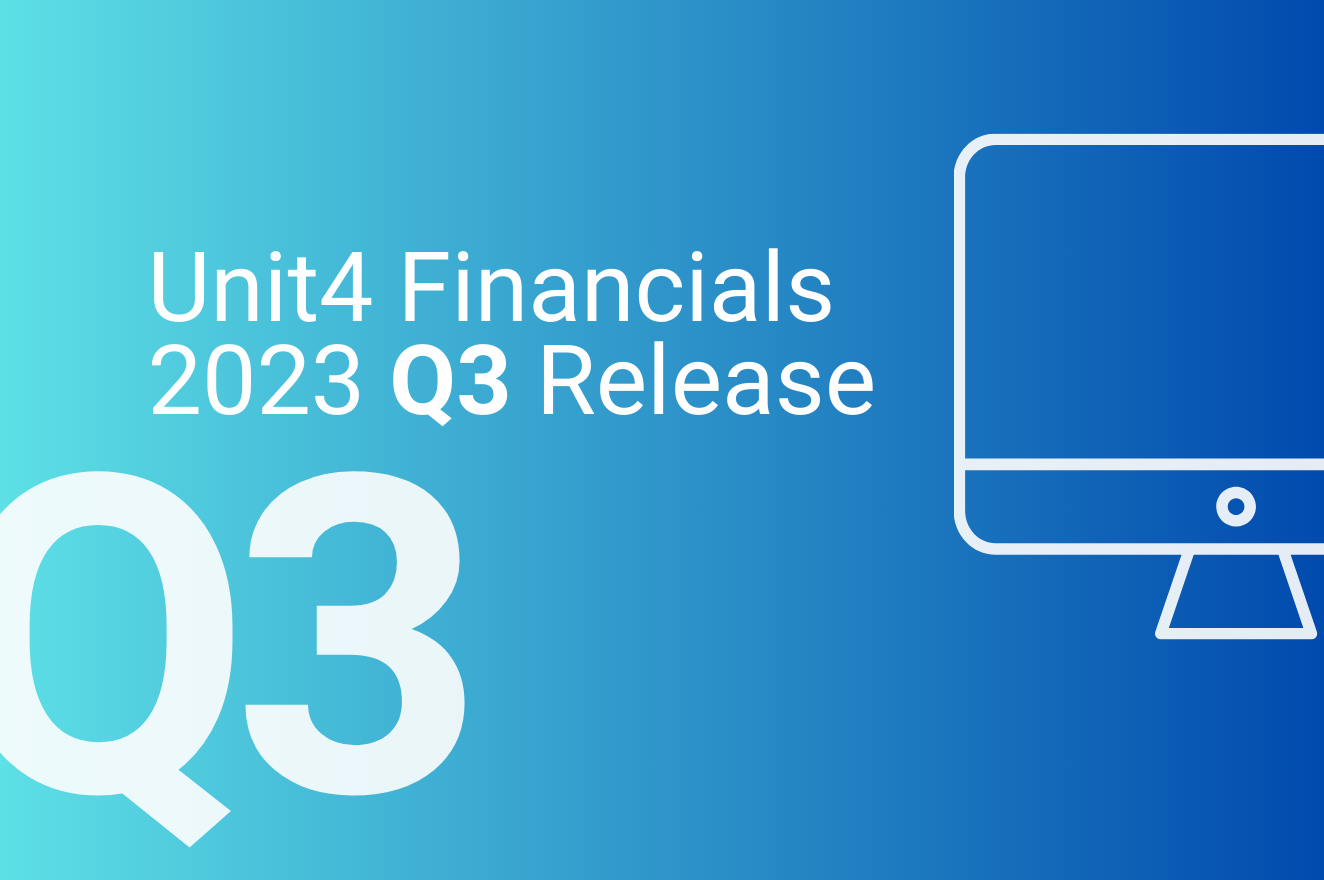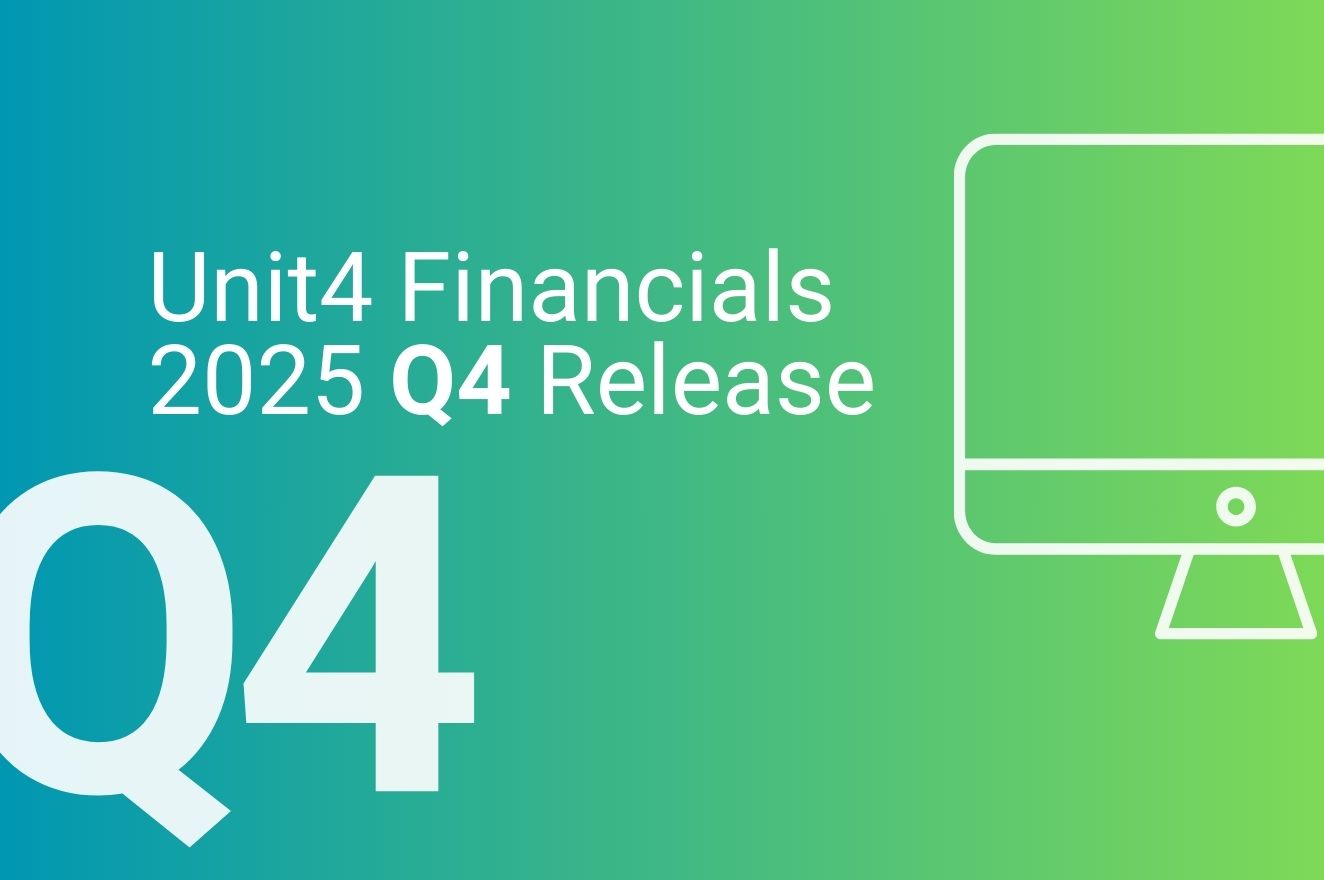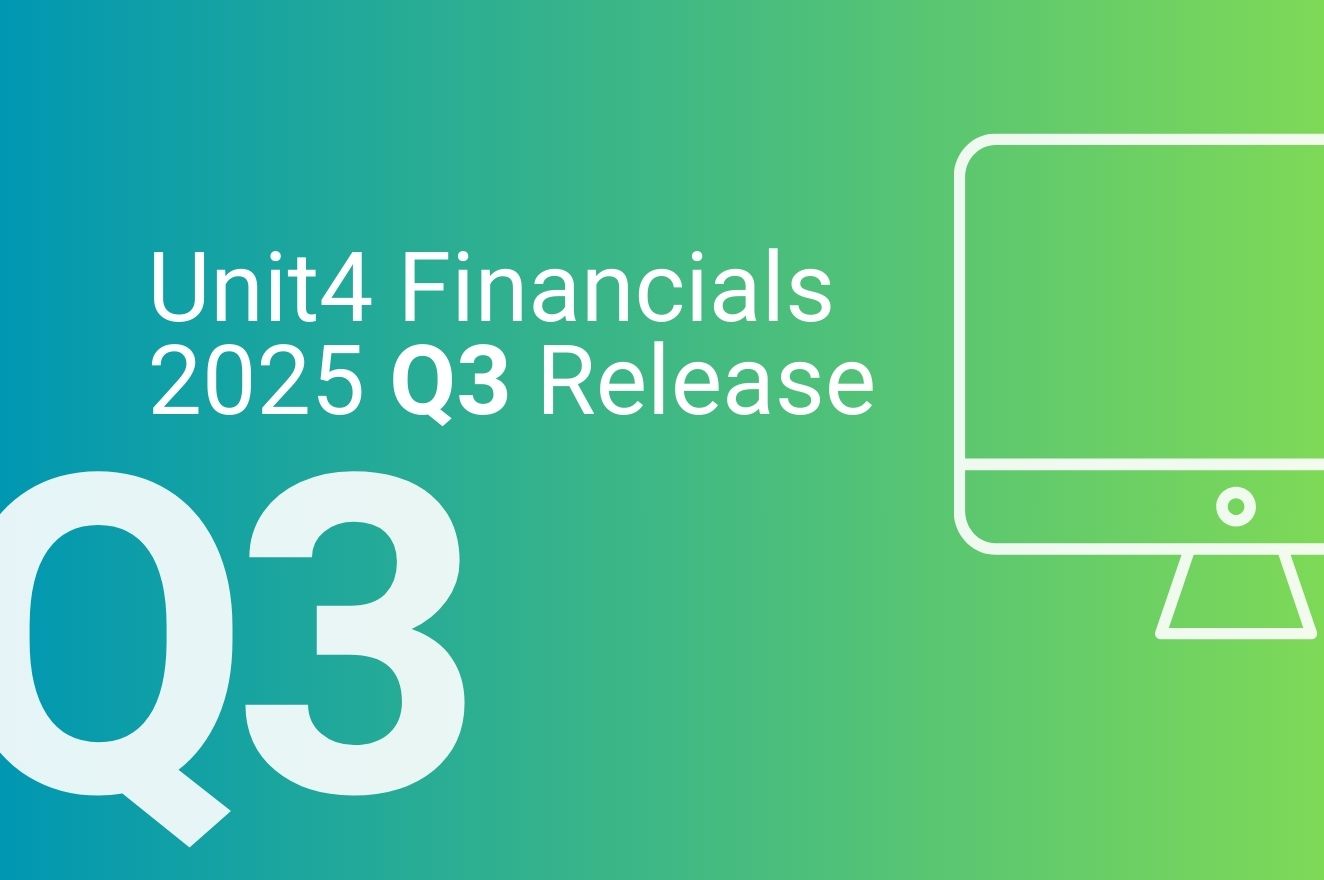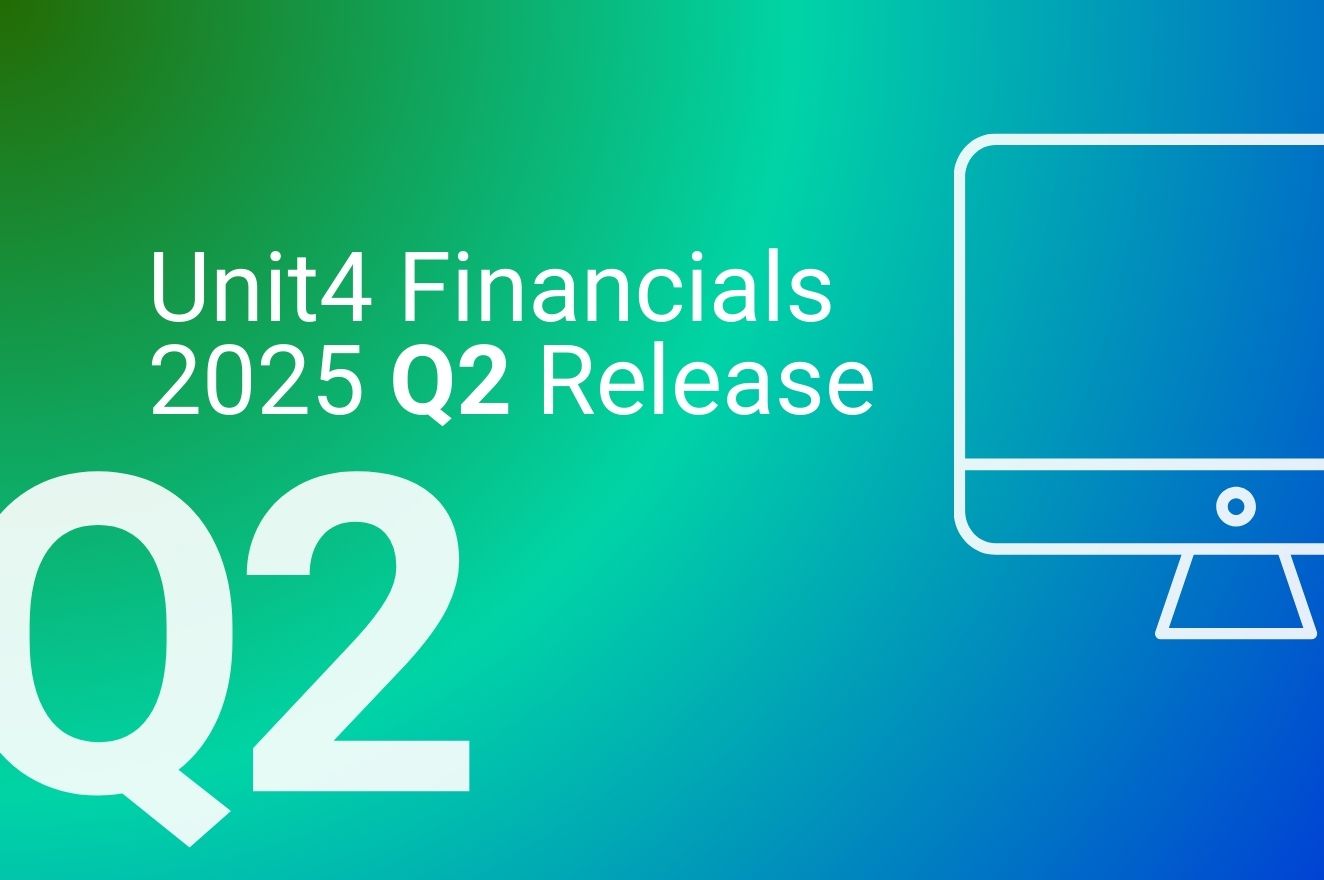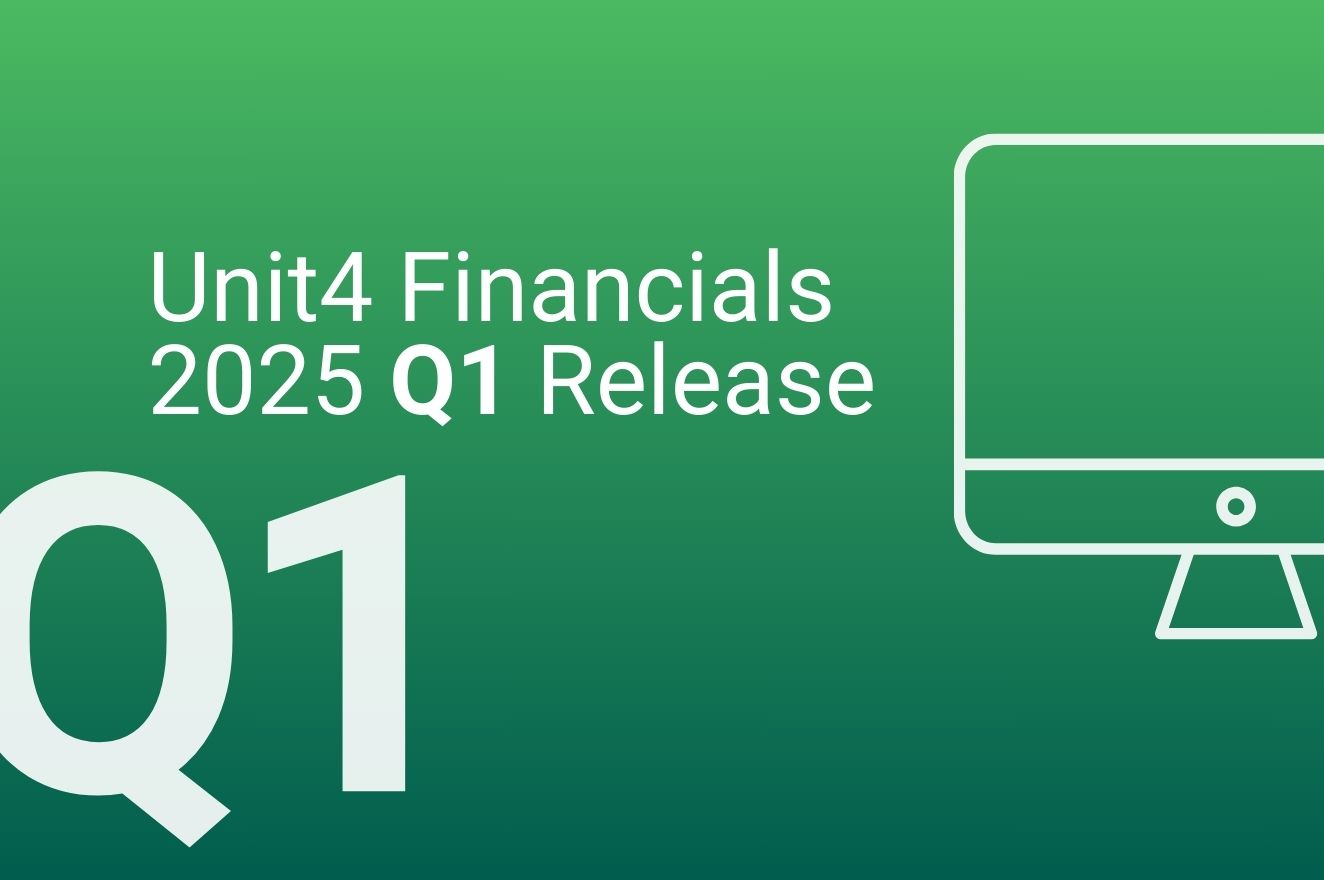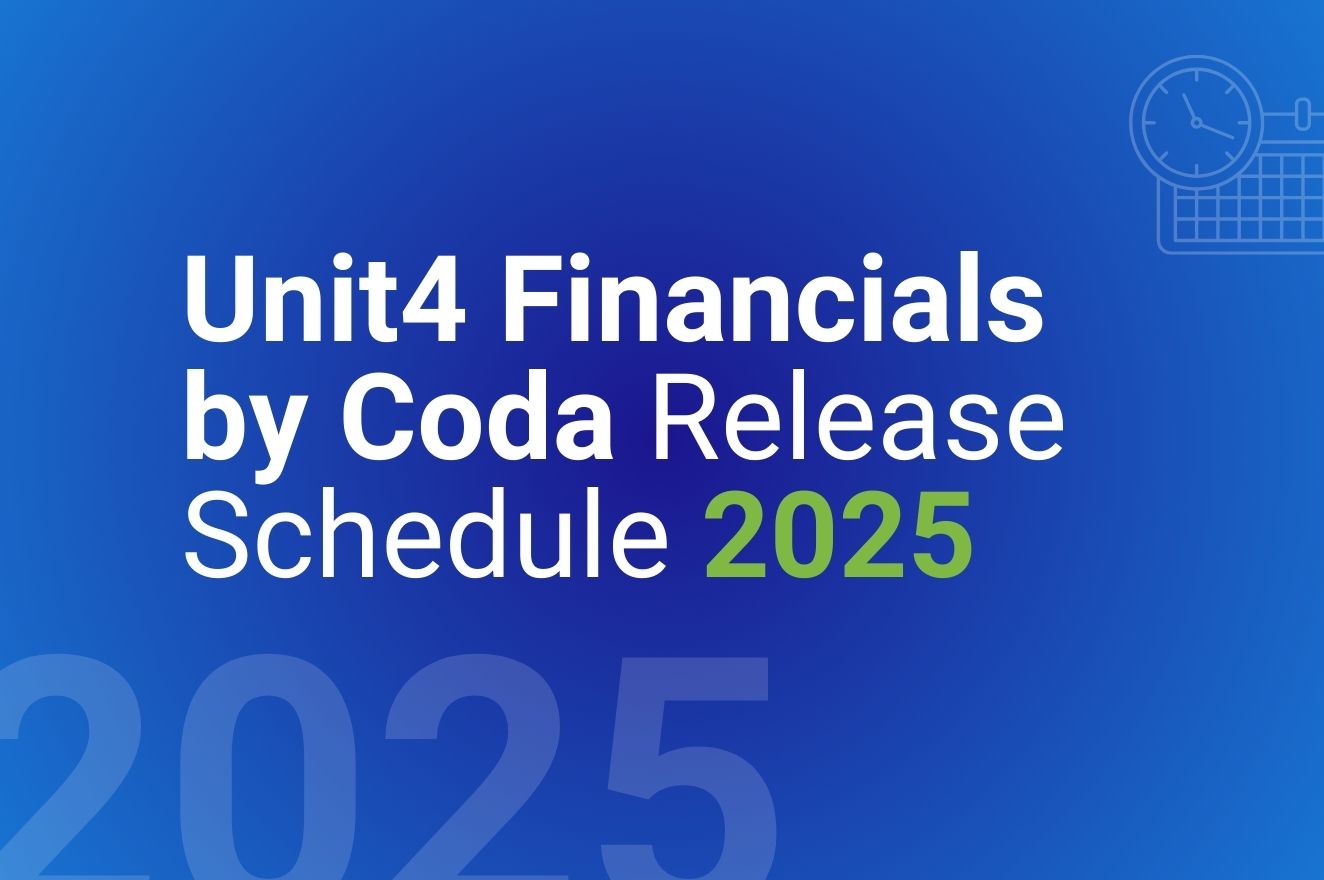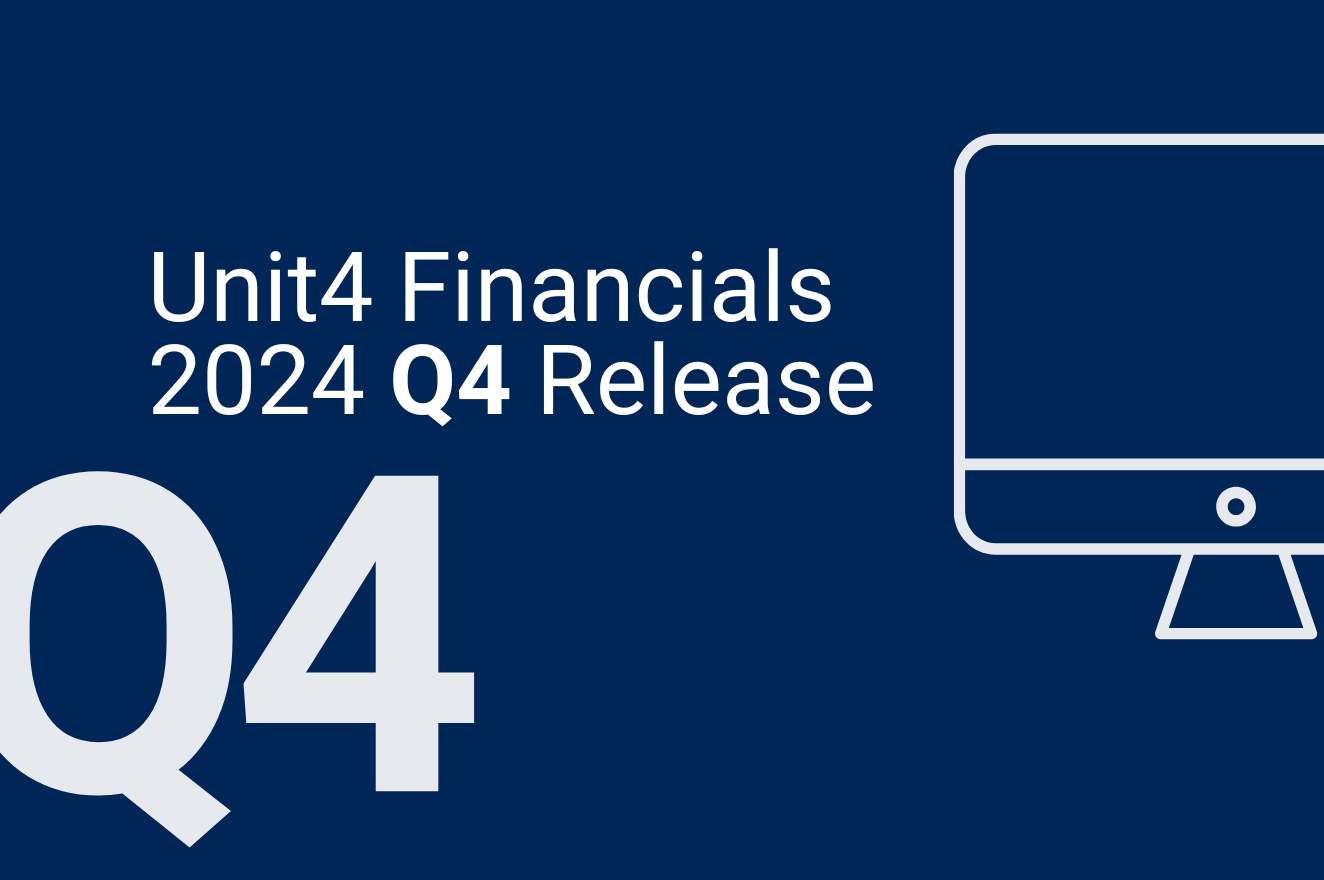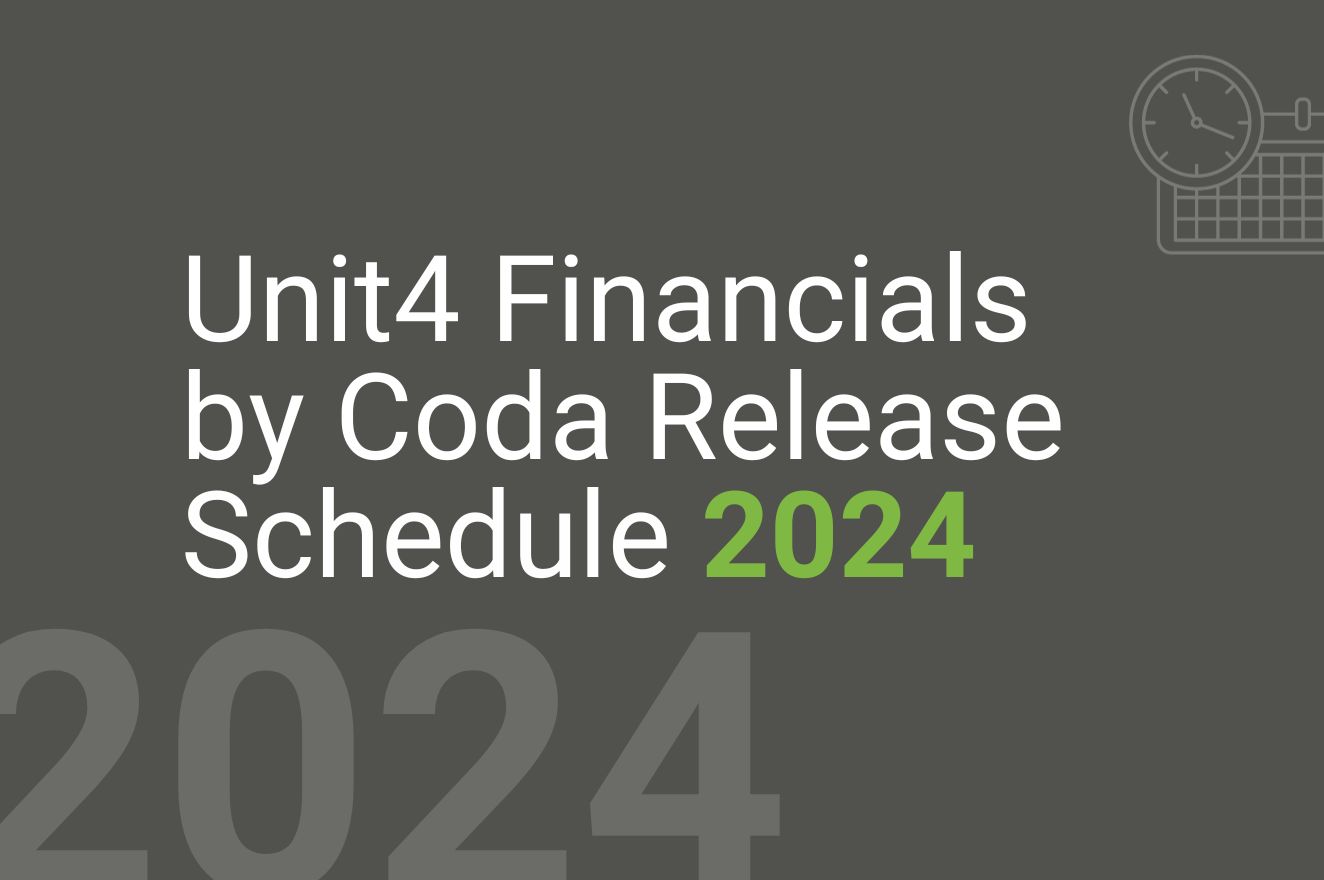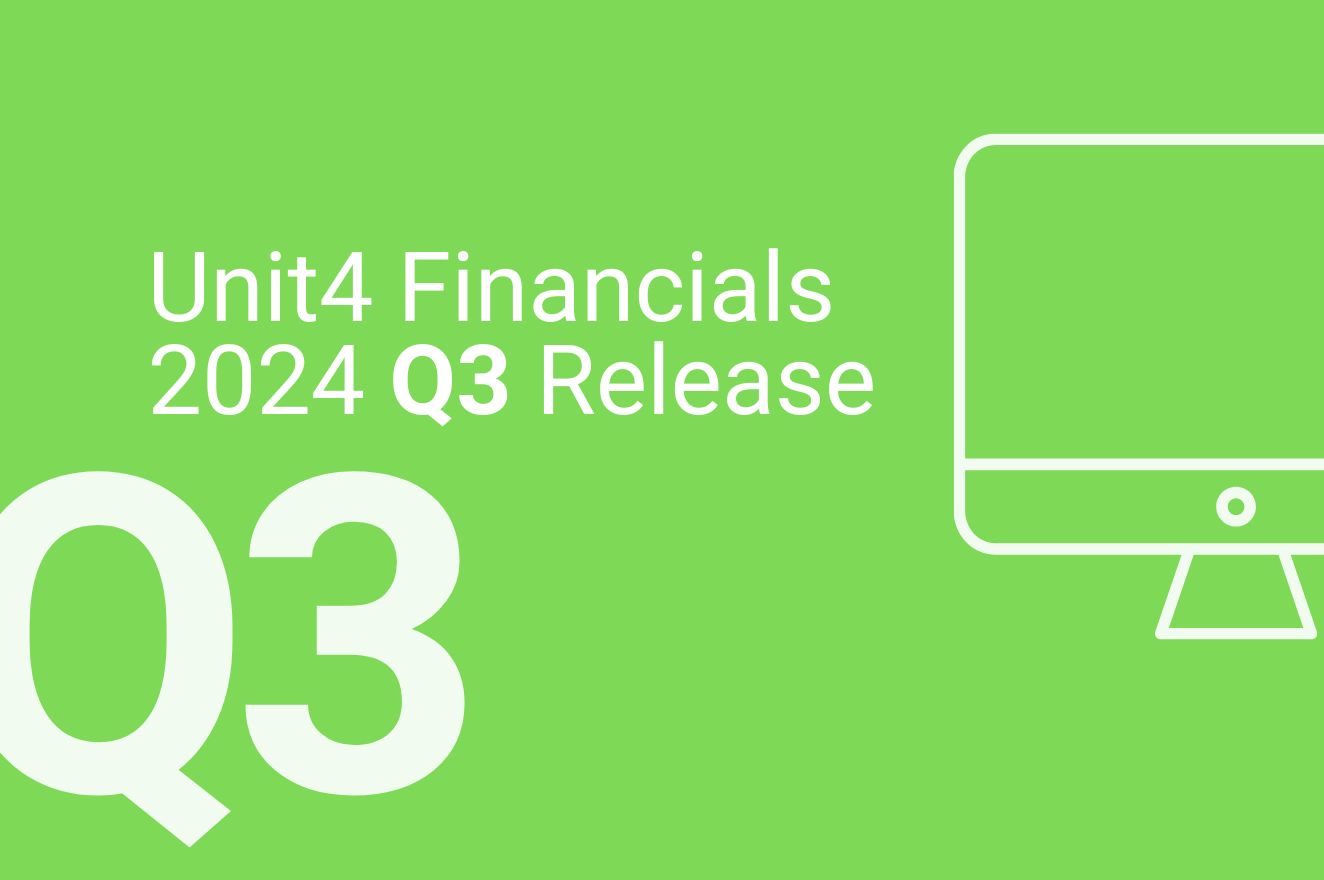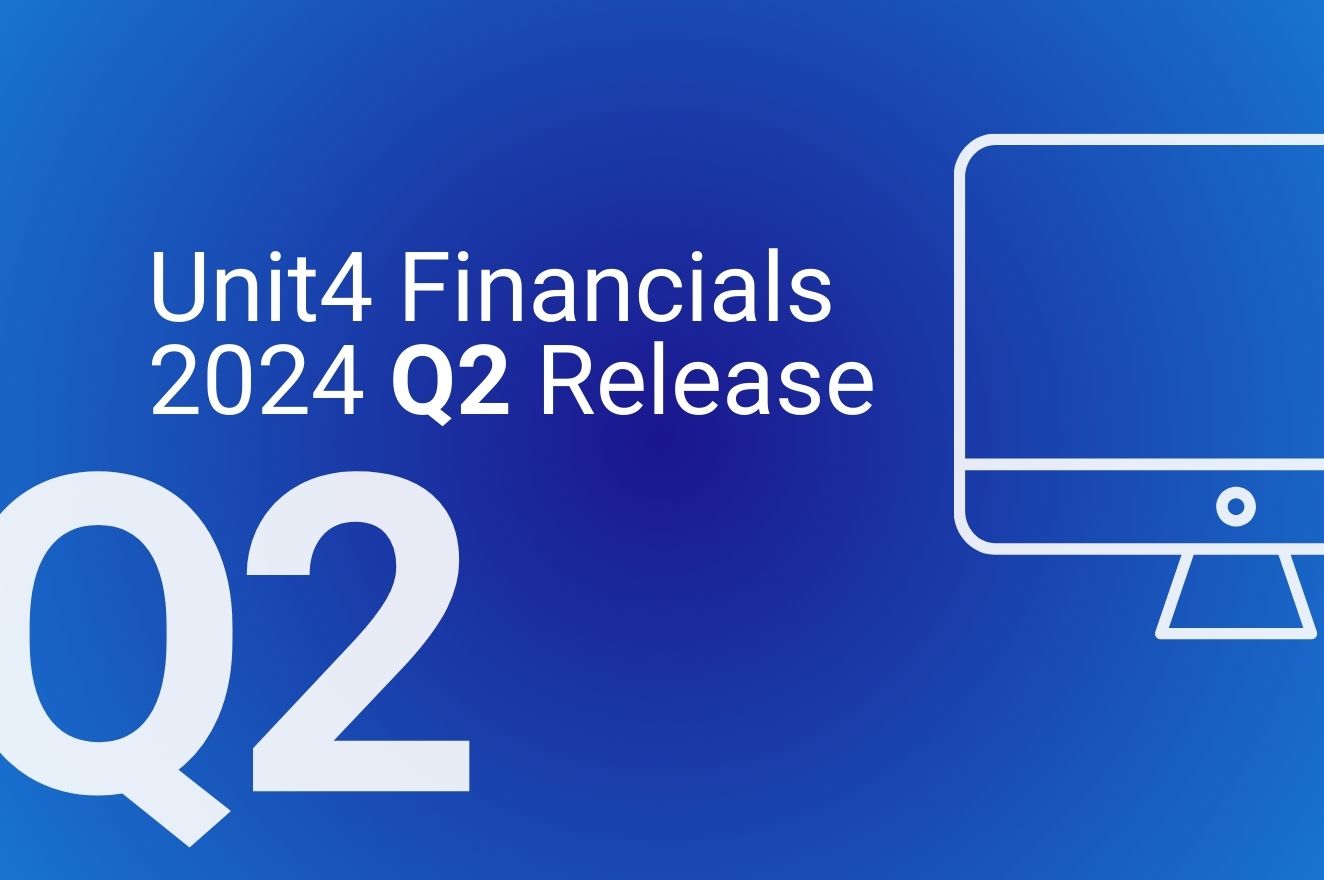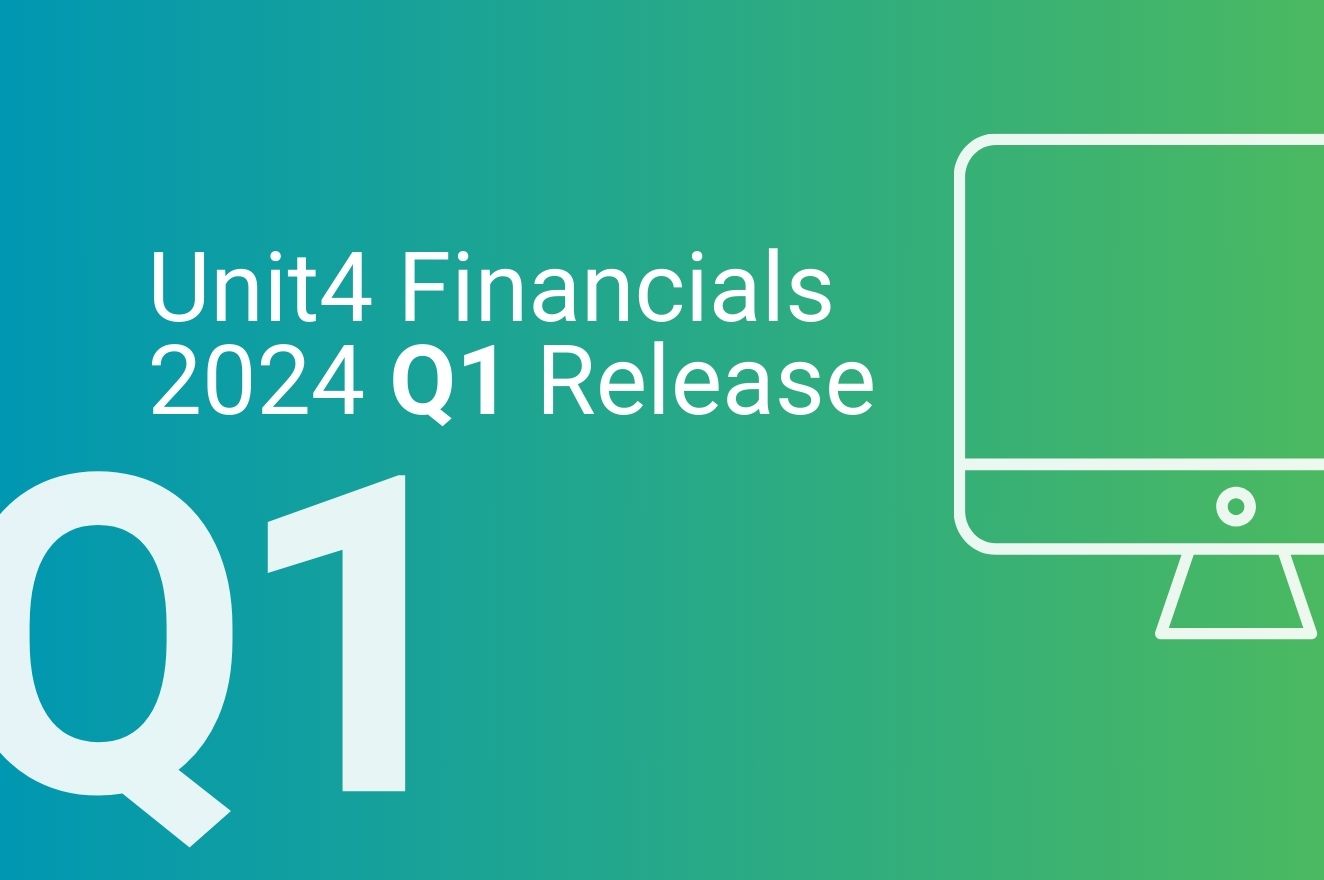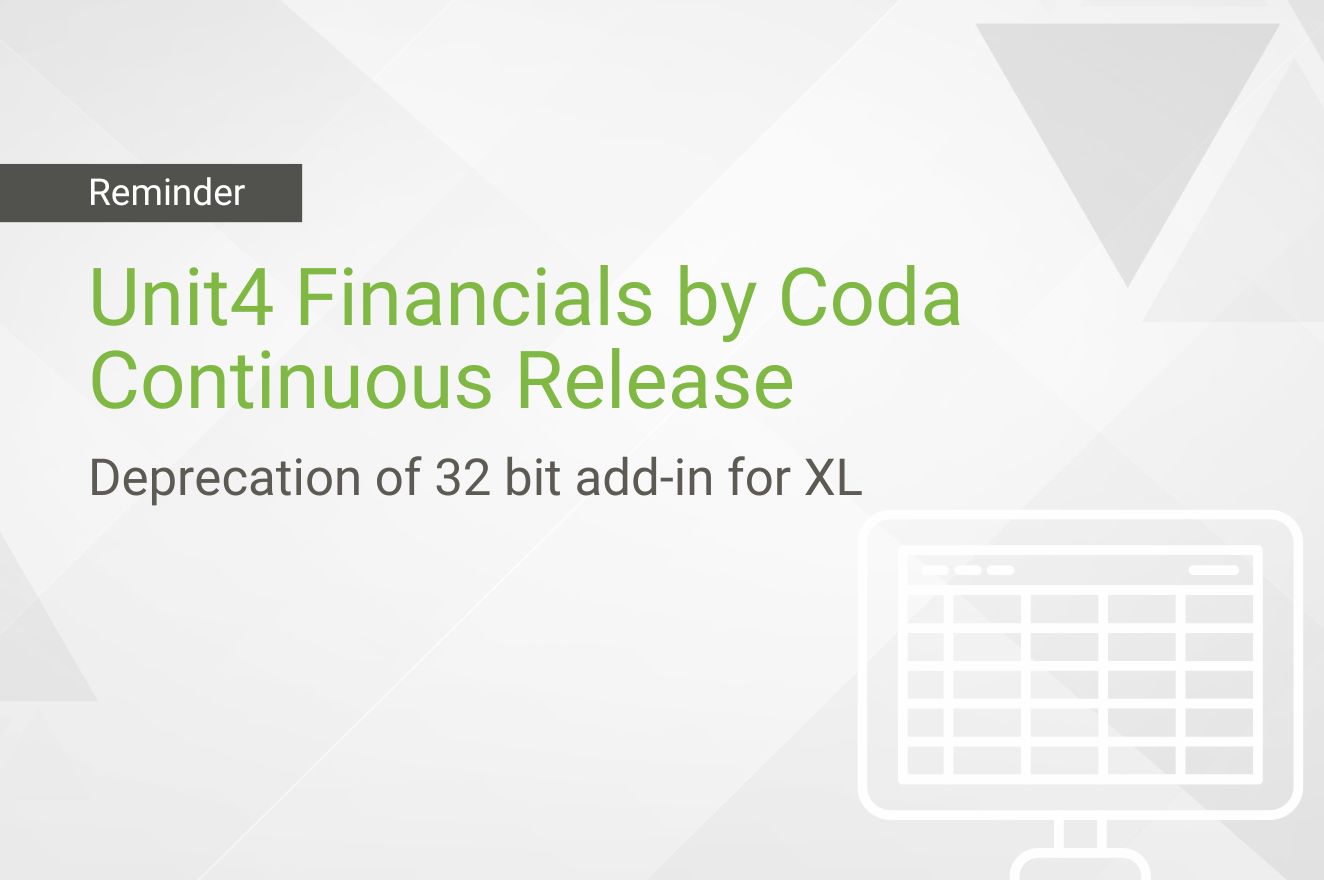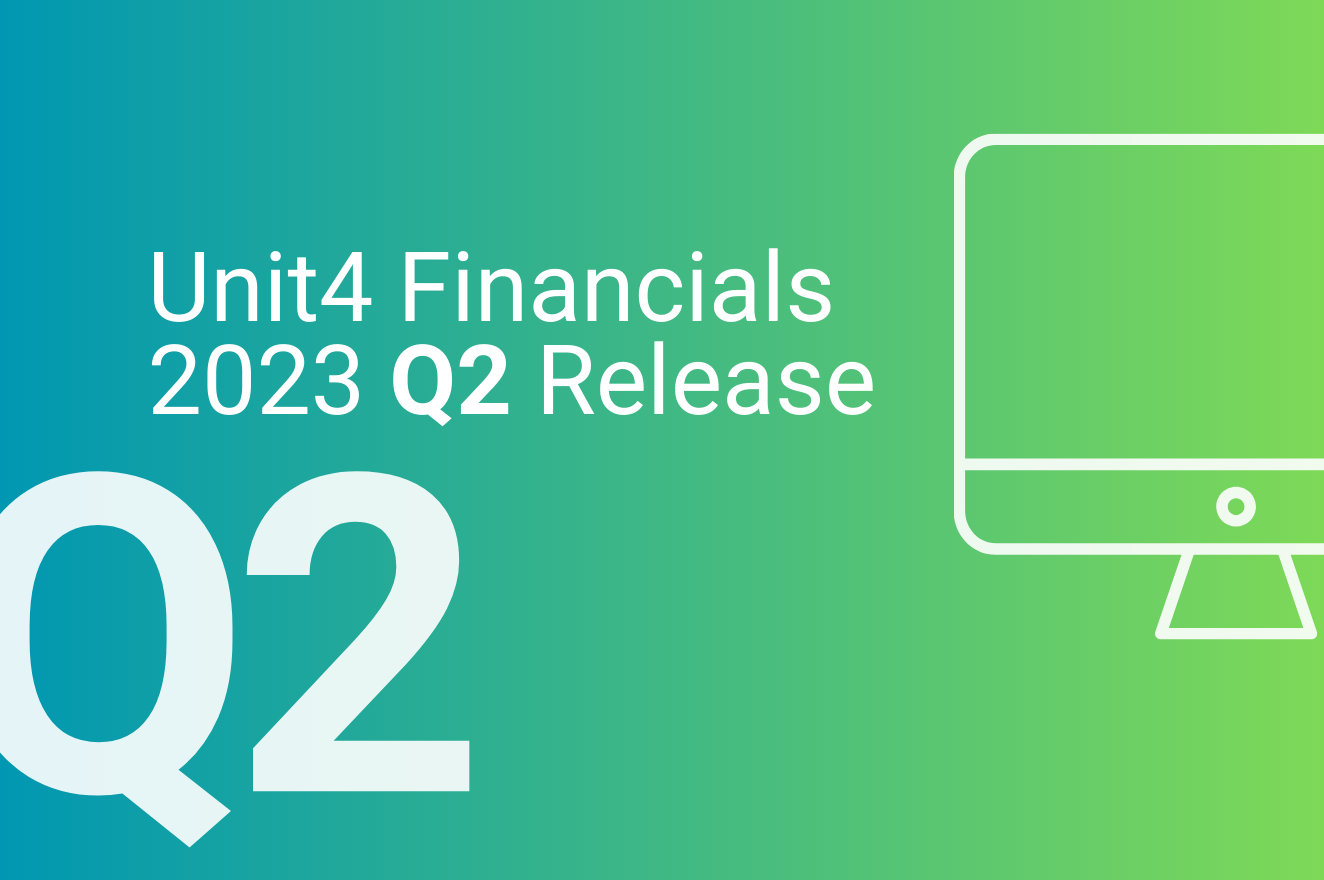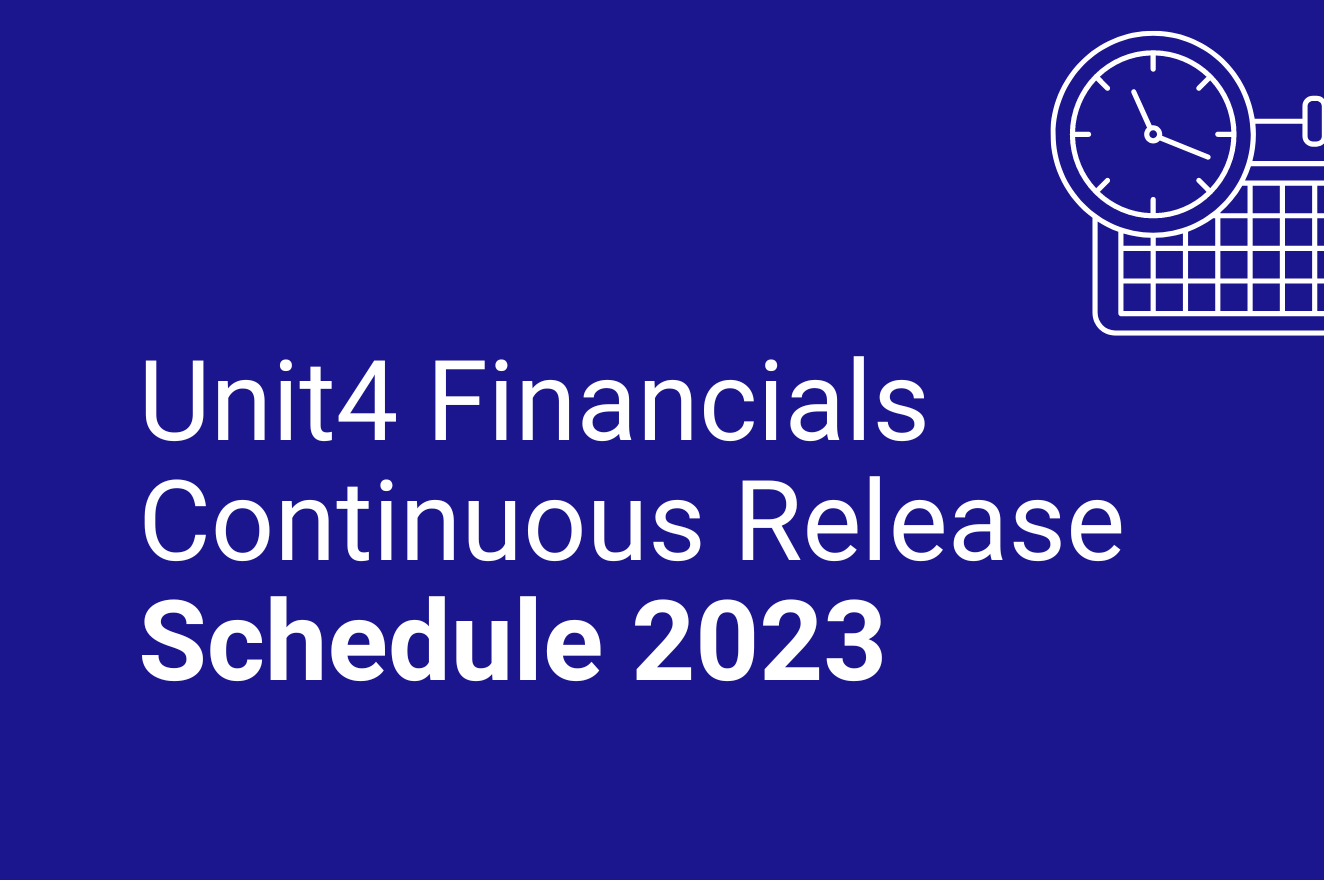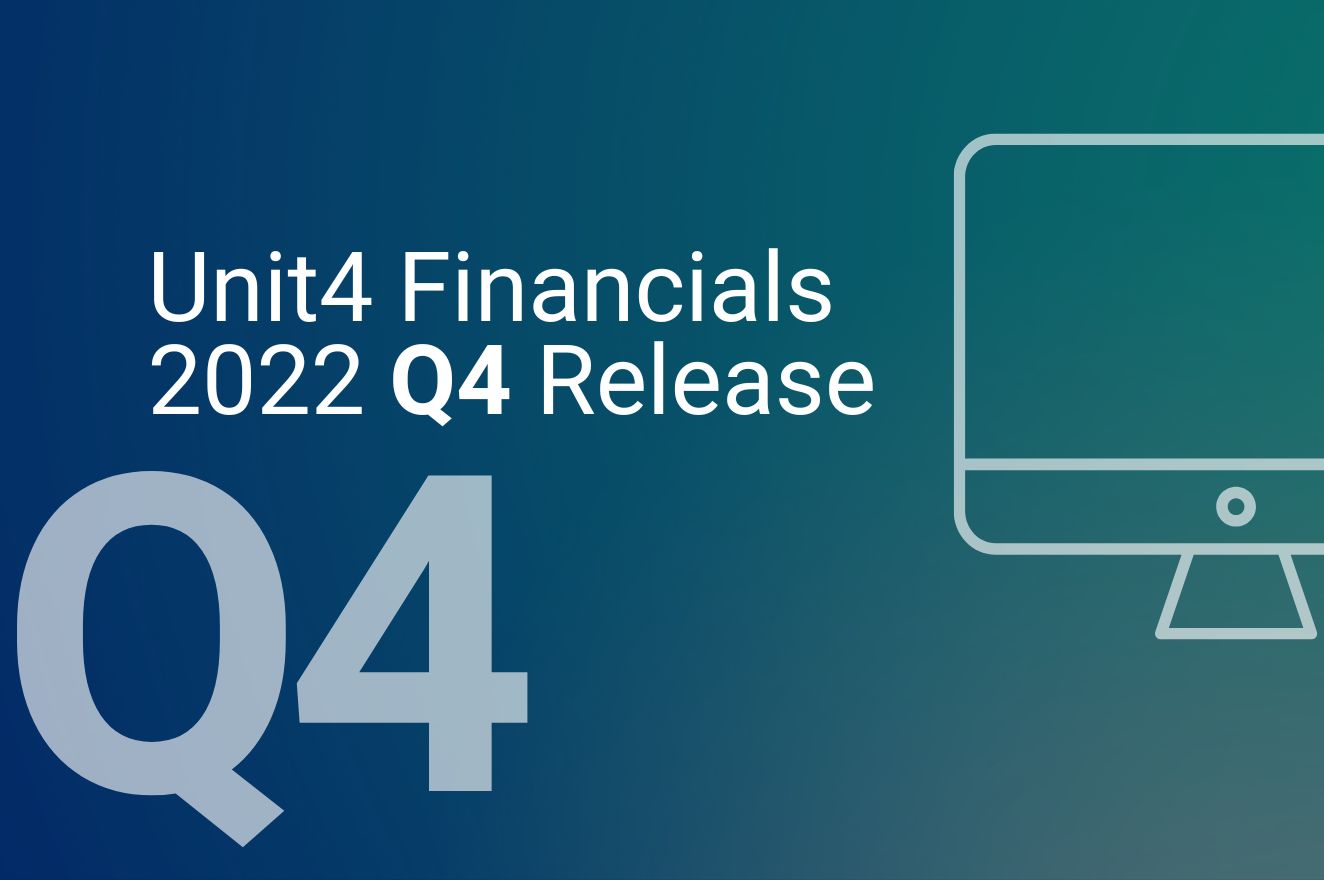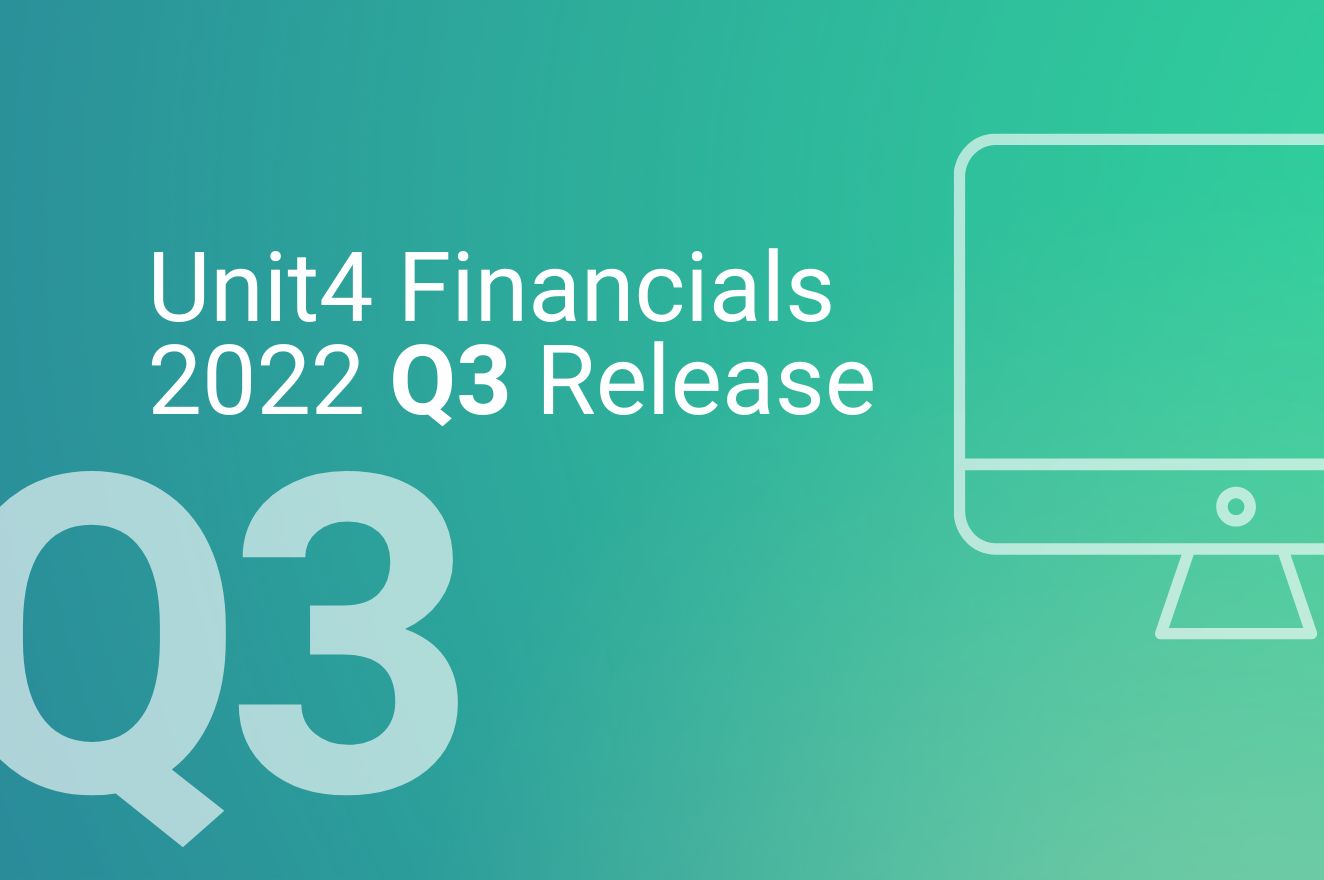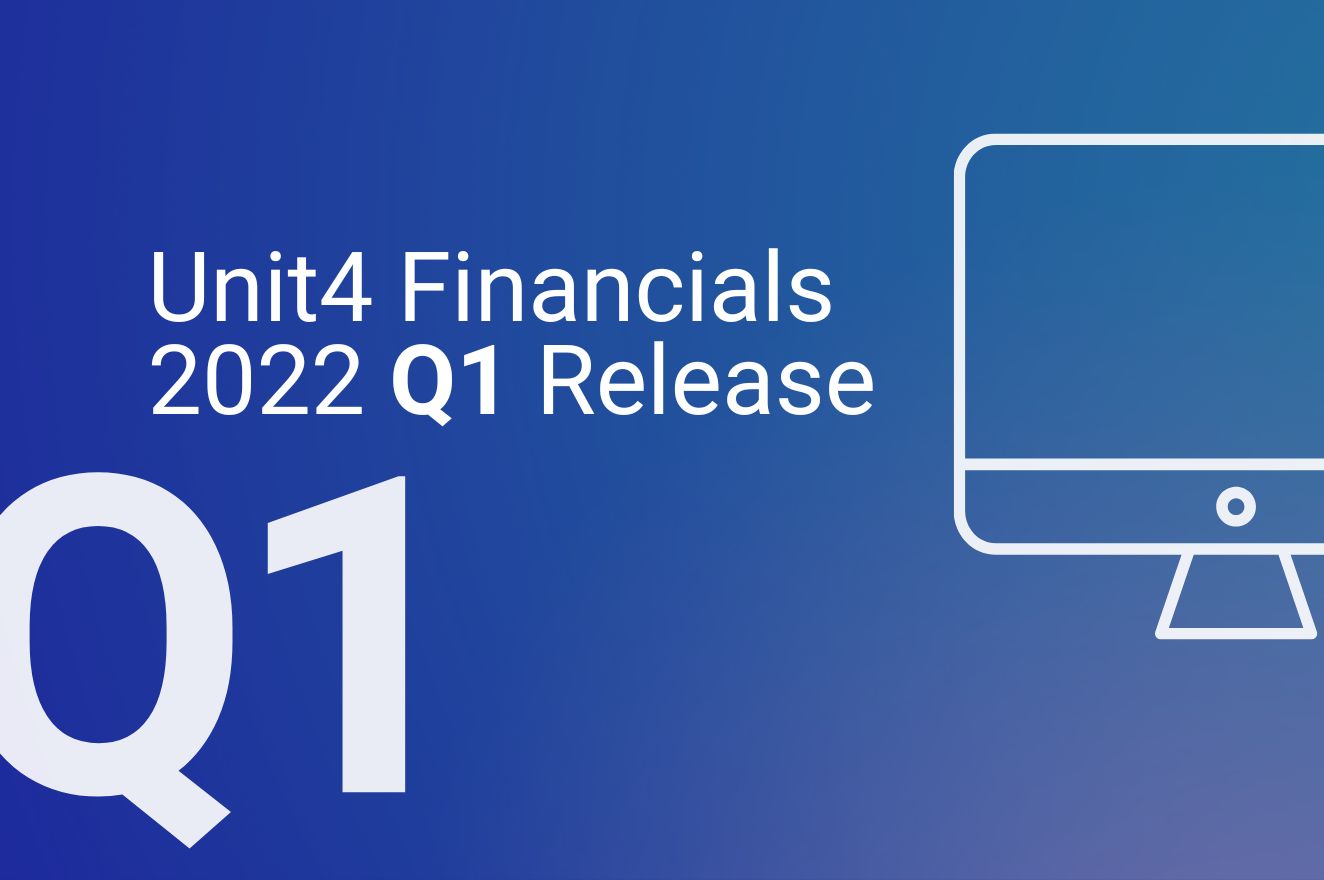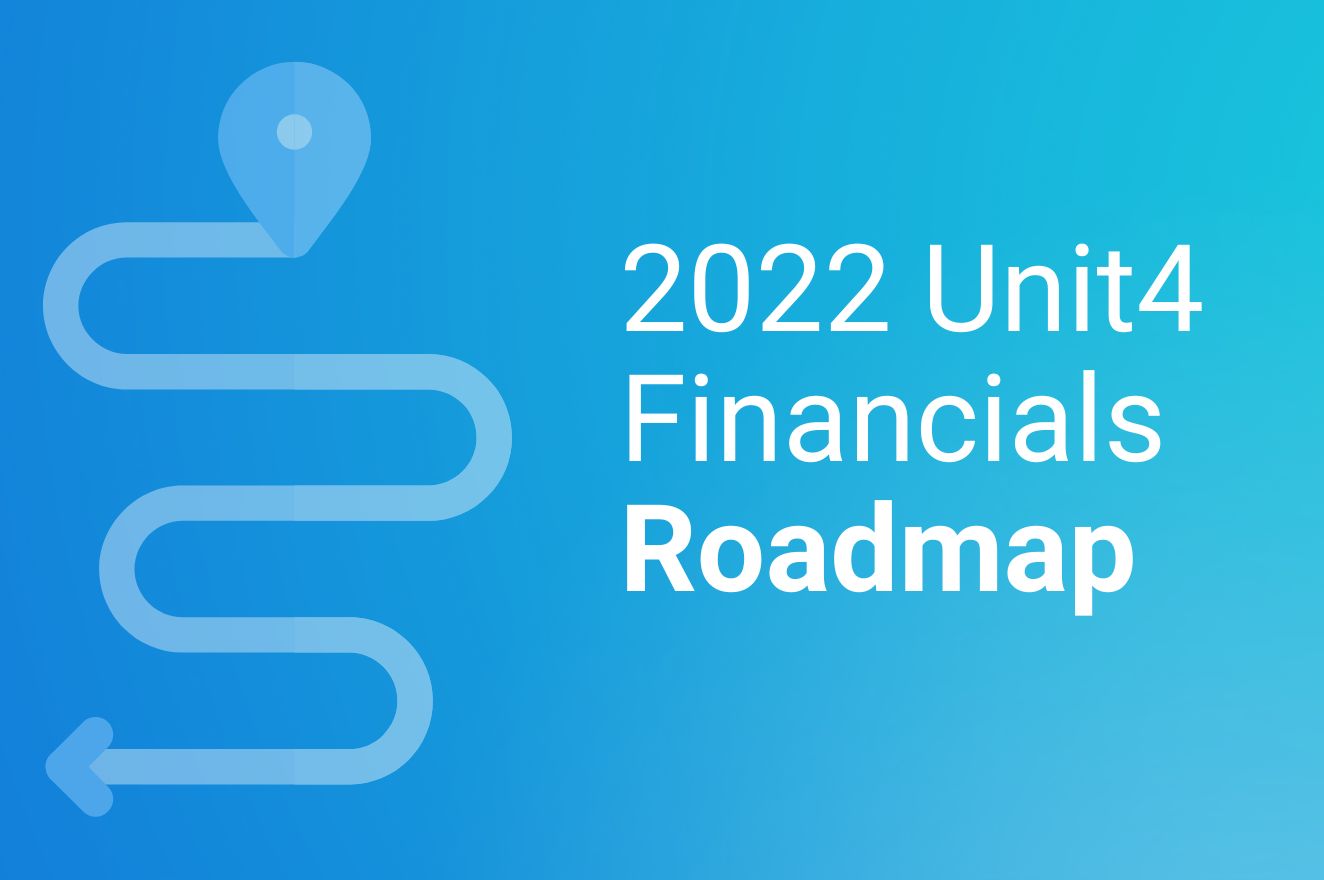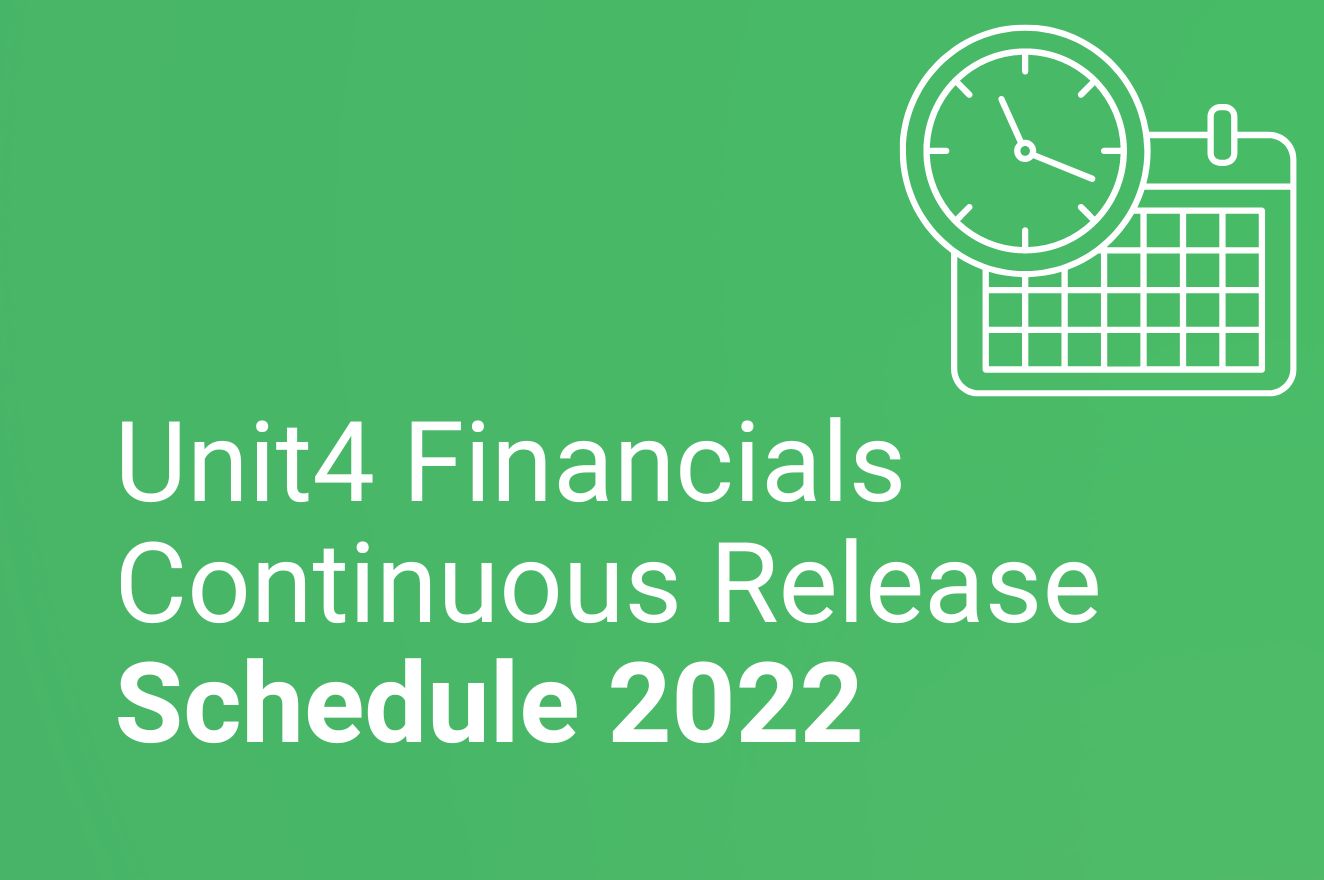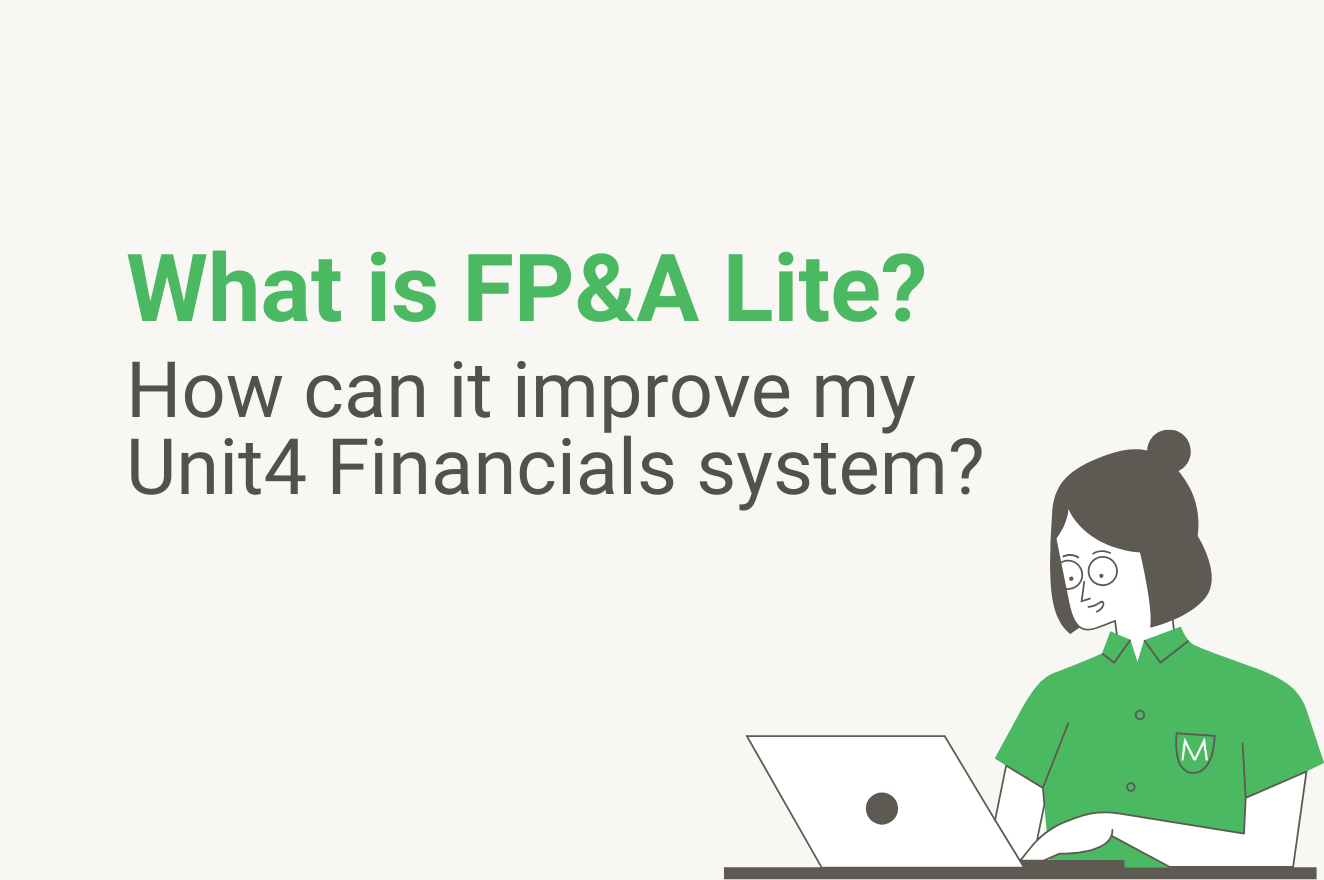Unit4 Financials 2023 Q3 Release
September 2023
Unit4 Financials by Coda 2023 Q3 was made available on 12th September 2023.
The new release contains all the previous Unit4 Financials functionality and new features. Plus, many additional customer requested fixes, highlighting the importance of logging enhancements via Unit4’s Community 4U.
Highlights of the 2023 Q3 release include:
Administration
- Webservice Index Page
- Generic Browse
- Internet Printing Security
Assets
- Year/Period Master
Finance
- Account Summary
- Company Master
Deprecated features
- 32-bit XL is deprecated. We recommend the use of 64-bit XL.
- The Message Board feature in Administration is deprecated. It will be removed in a future release.
General Fixes/Updates
- It is now possible to change a user’s password, when the user code contains a space.
- Attachments can now be viewed from the Generic Browse Content Provider.
- The private web service ‘clientauthenticate’ is no longer included in the public web service documentation.
- An issue has been resolved where the Generic Browse Master code could not be selected when configuring a new or modifying an existing Generic Browse on a menu content provider.
- An issue has been resolved where a session would sometimes consume licences for products which were not used.
- A serious error no longer occurs when maintaining Asset category masters with no ‘Category element value’ or ‘Cost centre value’.
- Forced Prompt(s) in the selector master for Link Table Maintenance now work correctly. This has been corrected for both Finance and Billing.
- It is now possible to include the ‘@’ character in External references in documents within Finance. This means an error will no longer be generated when posting documents from Billing or Invoice Matching that contain an ‘@’ character in a reference field.
- A warning message in Matching now appears if the capability setting of matching date outside the period range is set to warning.
- Documents posted using APIs, where the document currency values have more decimal places than the currency master are now posted correctly and can now be edited on the intray.
- Emails sent as part of the Pay/Collect process, where an email template master is not used, now includes the subject and text entered at run time by the user on all emails sent and not just the first email.
- On the IBM i platform the issue which restricted the ability to write to or retrieve data from the database repository has now been resolved, the repository objects (as used by attachments) are no longer corrupted.
- A rounding issue has been resolved when calculating the Home/Dual values, this issue occurred when using reversing tax and workflow to post books on approval.
- You can now enter configuration options in the Console without the com.coda prefix. This now enables IBAN verification to work correctly in the Dutch Local product NL Common.
- The WebSphere installation scripts have been updated to accurately implement the installation requirements. The previous WebSphere scripts could result in unpredictable behaviour and failures due to the configuration not satisfying Session Management requirements.
- A reflected cross-site scripting (XSS) vulnerability in the web user interface has been fixed.
- Cross-Site Scripting (XSS) vulnerability has been resolved when viewing attachments. HTML attachments are now downloaded rather than being displayed in a new browser tab.
- XML External Entity Injection (XXE) has been resolved. XML interpreter now cannot leak sensitive server side data back to the attacker from Request Body on /coda/finance/elementauthorisationrules/uploadrules page.
Further details on the new features, security updates and reported issues can be found in the release documentation on Unit4’s Community 4U.
- Unit4 Financials by Coda 2023 Q2 was made available on 13 June 2023, find here.
- Unit4 Financials by Coda 2023 Q1 was made available on 14 March 2023, find here.
Release dates for Cloud users
Unit4 Cloud customers are notified by Unit4 Cloud support when their pre-production and production systems will be updated. This information can also be found within the Cloud Services – Release Schedules area. View the 2023 Cloud Schedule here.
The Release Notes detailing the fixes and features within this release can be found in the Documentation area on Unit4’s Community 4U.
Upgrading Financials is not merely about accessing the new functionality that comes with a new software release. It is also about mitigating technology, operational, and business risk.
The Evolution of Unit4 Financials by Coda
The Evolution of Unit4 Financials by Coda
Guest post from Dave Anstey, Engineering Director, Unit4
– August 2023

What’s the difference between run-of-the-mill and best-in-class when it comes to accounting and financial management packages?
There’s no single magic ingredient that makes a good solution great. Of course, it’s essential to get the fundamentals right – e.g., solid core accounting capabilities and a ledger that’s always in balance, a user-friendly experience, and easy integration with the rest of your tech stack. And in an ideal world, your solution should deliver visibility and control across your company’s people, processes, and systems.
However, if you really want to understand what makes Unit4 Financials by Coda stand out as a great solution, it’s worth taking a brief look at how it has evolved. Architecturally and technologically, it has been completely transformed over 20-plus years. But none of this is about extraneous gizmos or change for change’s sake. Rather, it’s about ensuring that finance departments are equipped to handle their most pressing operational challenges; whether they be new regulations, doing business in new markets and volatile conditions – or responding to internal pressures to do more with less.
Here’s a closer look at how Unit4 Financials by Coda has evolved to meet customer needs – and at what the future holds…
20+ years ago
At this time, Unit4 was releasing software versions for Coda (as it was then known) and its other enterprise offerings approximately every three years, with maintenance releases approximately every six months.
Responsiveness to customer needs was always a key part of the company’s ethos. As such, Unit4 was heavily invested in responding to what were known as SARs (special ad-hoc requests): a huge but important undertaking for the company’s maintenance and engineering teams.
As was the norm for enterprise software at the time, installation of Coda was a manual and heavily time-consuming process: a vast difference compared to today.
15 years ago
How can we get new and potentially highly useful functionality into the hands of our customers faster? This was the perennial problem faced by enterprise software providers at the time, and Unit4 was one of the companies committed to optimising roll-out schedules.
The introduction of service packs facilitated quicker routes for delivery (far more efficient and less invasive than new version releases). Inroads were also made into a quicker and easier installation.
10 years ago
At about this time, Unit4 switched to EAR files (Enterprise Archive files) as a deployment methodology for the software. Starting with the web tier, and then the application tier, the use of EARs meant deployment could be achieved much more rapidly.
This led to a reappraisal of the company’s software architecture (Why have we got separate tiers for both our software and servers – and how can this be rationalised?”)
The result was a new, single-tier structure, with the deployment of the software being the same whether it’s on-premises or cloud. This was yet another leap forward in terms of easier software deployment and upgrade.
2020 and the arrival of Continuous Release
“With our new architecture in place – and the old database and schema restrictions a thing of the past – we’ve got the ability to roll out new and improved functions very rapidly. So why not formally commit to doing this – frequently and regularly?”
From early 2020, Unit4 now releases Financials by Coda updates every three months. And given the sheer volume of new challenges finance departments have had to face over the last three years or so, the timing of this could hardly have been more relevant.
The future: Cloud
Unit4 has long been committed to developing its Cloud offering – but that’s not to say that this development doesn’t benefit on-premise deployments as well.
By way of illustration, as far back as 2012 (release Version 13), Unit4 introduced support for internet printing protocol. This was an early step to moving away from the physical server.
Until this update, if you wanted to print from Financials, you had to hook your printer off the back of the server where the software was deployed. Now you can print to any printer in the world that has an IP address, just configure it up as a printer – it’s that easy.
In Version 14 (2017) Unit4 removed the desktop as well as desktop-based integration capabilities. At this time, the company also introduced multi-factor authentication with the Unit4 identity server. All the while improving feature function, delivering products, looking after the architecture, working towards the Continuous Release model, and building Cloud readiness.
At this time Unit4 also started assessing the existing integration capabilities. The problem was that many of these capabilities were not suitable for Cloud as they were based on tables on the desktop. Table link, for example, the batch input that ‘everybody’ uses, wouldn’t work in the Cloud. So Unit4 developed a Cloud integration for Table Link.
The company also introduced safer hashing algorithms. By evolving its thinking, Unit4 is delivering a product that is not just feature-rich but is also firmly focused on keeping users safe, current, and up-to-date with technology. This is an ongoing commitment for Unit4, with improved cost of ownership and REST APIs coming up, a step forward from the previous SOAP APIs.
Next Unit4 plans to look at Office 365 Web, because (as of publishing) you still must have a desktop add-in integration for Excel. The company is also looking at containerized deployment and so on.
What does that mean to us as a Financials user?
Upgrading Unit4 Financials is no longer a complex, time-consuming task.
Since launching Continuous Release at the beginning of Q1 2020, Unit4 has issued 14 quarterly releases, with 75 (and growing!) customers on Continuous Release.
The end result is a lower cost of ownership, stronger security, platform adherence, ease of installation, and regular feature updates. In short, everything you need to ease your transactional workload, stay on top of compliance, and handle the challenges ahead.
Discover the latest Unit4 Financials releases
Complex Billing Challenges Solved
July 2023
Unit4 Financials by Coda
Complex Billing Challenges Solved:Introducing MBilling for Unit4 Financials by Coda
As a business evolves, the finance function must ensure that billing processes remain fit for purpose. A sub-optimal billing system can leave you with cash flow woes, revenue leakage, dissatisfied customers, and a mountain of extra work to handle.
Millennium’s powerful sales invoicing solution, MBilling can provide a future-proofed alternative to legacy processes. Designed for Unit4 Financials by Coda customers and underpinned by order-to-cash specialists, MBilling ensures billing processes are able to support business growth – rather than being a barrier to it.
Here’s a closer look at the challenges associated with complex billing and at how MBilling can address them.
Complex billing defined
According to McKinsey, 71% of consumers expect a personalised approach from the companies they do business with. Meanwhile, 80% of B2B buyers expect the same buying experience as B2C customers, with 65% of business buyers saying vendors are not demonstrating an adequate understanding of their needs.
With customers increasingly demanding a personalised service, many businesses are finding that a rigid approach to billing is no longer good enough. Tailor-made packages and usage-based pricing are often a much better fit for customer expectations than ‘take-it-or-leave-it’ bundles.
Between 2021 and 2022, the global subscription market grew from $72 billion to $120 billion. It’s part of a wider trend of businesses taking a long hard look at pricing and distribution before tweaking – and in many cases, overhauling – their model. The end result can often be a complex web of tiers, personalised price plans, subscription options, and add-ons.
All of this has a direct impact on accounts receivable. Whenever pricing policies are altered to make the customer experience more personalised, rarely do those changes make the model simpler! Invariably, the list of variables by which you engage financially with customers will be extended substantially.
The end result is that you find yourself operating in the realms of complex billing. This is where invoices are no longer dependent solely on volume or time. Rather, billing takes into account a wide range of parameters, which could include bespoke contractual agreements, customer type, size and location, preferred payment method, loyalty discounts, and special plans (to name just a few).
Complex billing challenges
When it comes to administration and management, complex billing can give rise to the following issues:
In a simpler world, drawing up an invoice meant checking the volume and matching it against a set price list.
Once you are in complex billing territory, there is a much wider range of variables to take into account. What category does this customer belong to? What does the contract say? What optional extras or discounts are relevant? What special terms have been agreed at different stages of the customer journey?
The answers to these questions may not all be in one location. Depending on your tech stack, key information could be scattered across various CRM and finance systems, contract repositories, pricing documents, spreadsheets – and even email threads lurking in account handlers’ inboxes.
Against this backdrop, the billing process involves the collection and consolidation of data from disparate areas of the business from multiple systems and in multiple formats. It’s a recipe for error – and for a drawn-out process.
Difficulties with complex billing are often compounded in the case of transactions with an international element. Along with all the data-gathering issues detailed above, you can also find yourself dealing with complications over region-specific pricing policies and currency conversions. This may be in addition to VAT, invoice formatting and other regulations that can vary per product, per customer, per company, and per country.
The business risks associated with sub-optimal billing processes are pretty obvious. If those processes are prone to error, this increases the likelihood of customer queries, lengthening the time-to-payment – with knock-on implications for cash flow, and possibly also revenue leakage.
Does this enterprise client’s 5% volume discount apply before or after the loyalty bonus? Should I treat this element as part of the package or as an optional extra? If billing is a manual process with lots of variables to consider, it can increase the chances of finance team members or branch offices adopting their own interpretation of the rules.
The emergence of an inconsistent billing process is a further risk that should not be overlooked. If your customer’s accounts payable team notices that bills vary from quarter to quarter – depending on whoever happened to be responsible for calculating it – then an erosion of trust is inevitable.
A company’s billing process tends not to be simple one day and then complex the next. More typically, it grows in complexity as go-to-market and pricing strategies evolve. Consequently, the workflows linked to billing – e.g., the systems you need to access to gain relevant information, pricing data to consult, and the signoffs to seek – can also evolve over time.
One problem here is the risk of a single point of failure, e.g., the existence of just one person in your team who understands the Excel formula used to apply a certain billing rule in the right way.
Another problem relates to the onboarding of new people. Longstanding team members will have absorbed your various process changes organically over time. For new recruits, however, it’s a case of getting them familiarised with what may be a complicated and counter-intuitive series of tasks. Training in this area can be a complex process in itself.
What is MBilling?
MBilling is Millennium Consulting’s powerful and flexible billing solution, designed to address exactly the kind of issues detailed above for companies with complex needs, or who need to generate high volumes of invoices.
The solution is underpinned by ICORP, a leader in order-to-cash technology, designed to be customised to precisely meet your billing requirements – however complex your operating model.
Seamless integration is a key feature of the solution. It is built to work with Unit4 Financials by Coda, both on-premise and in the cloud. It offers frictionless integration with whatever ERP system you use, external applications and databases – including Microsoft Excel and email solutions.
How does MBilling work?
With MBilling, you can finally replace those error-prone and resource-intensive workflows for the collection of the data from disparate sources necessary to generate invoices.
The ICORP algorithms under the bonnet of MBilling are data miners par excellence. The system will automatically identify and lift all relevant data – including, for instance, email attachments – and apply them to your system as structured data. The process is quick, accurate and error-proof.
Through its calculation engine, MBilling can calculate the pricing for your billing, taking into account all relevant variables (e.g., tax, product, customer characteristics, etc) according to rules defined by you. The process is fully automated but also allows you to set whatever validation steps you wish to apply. The system can also deal with automated intercompany bookings – with a useful function dedicated to royalty rights. (It is also possible to turn MBilling around, for instance, artists and producers could use the system to send a payment run.
Once the system has completed the complex billing calculation, the bill can be generated automatically.
If you want it to, MBilling can take all the invoices for one specific party and consolidate them in one large invoice. The frequency at which it generates invoices and all the rules behind it are completely configurable by you. It can do one-to-one invoicing if you want to. It can deal with multi-language invoicing – it will recognise the individual recipient and compile it accordingly. The solution can handle reverse billing and invoicing, repeat billing and invitation to invoice. All with validation and approval where desired.
You can also configure your solution to automatically forward invoices to relevant internal parties for approval.
You can configure rules for invoices to be printed, emailed internally or externally, or integrated according to whatever policies you have in place.
Relevant information will be posted automatically to Unit4 Financials, including intercompany processing where relevant. This full Unit4 Financials integration applies whether you are on the cloud, SaaS, VM, or on-premise.
The ICORP Intelligence Monitoring Tool is hardwired into the MBilling solution. This ensures full data alignment so that when a bill is issued, the transaction is fed through immediately to your master data, so you always have access to a real-time picture of business performance and financial health.
What next?
By implementing MBilling, Unit4 Financials users can always be confident that invoices are accurate and submitted in a timely manner – no matter how complex your operating model is. To find out more, download our factsheet or submit your details and one of our MBilling experts will be in touch.
The benefits of FP&A Lite for Unit4 Financials
FP&A Lite
July 2023
The benefits of FP&A Lite for Unit4 Financials
Unit4’s add-on, FP&A Lite enables you to perform ad-hoc, self-service analysis on your profit & loss, balanced sheet, and cash flow statements on a central, secure, and connected environment. All are tightly integrated with your financial data source, Unit4 Financials by Coda, to boost trust and agility in analysis and decision-making.
Read on to discover the benefits of this easy-to-use, easy-to-deploy analytics solution for your finance function and for the wider business.
The go-to analysis tool for many organisations is Microsoft Excel. So, for instance, if you are a Unit4 Financials user and you want to interrogate your underlying financial data, the old way of doing things tends to involve using the Excel add-in to connect to the solution, pulling the data out, and then applying Excel’s filters, pivot tables, formulas, diagrammatic representations, and other tools.
Analysis through Excel is, however, a largely manual process; one that’s often both time-consuming and resource intensive. No matter how careful you are with validation, errors are pretty much inevitable. Even a minor mistake (e.g., the wrong input in the wrong cell or accidentally swiping over a range) can have major consequences for decision-making, resource allocation and, ultimately, your bottom line. Meaning you are unable to trust the data on which you base the financial health of your organisation.
Financial analysis is a collaborative process involving multiple team members. Excel, however, was devised primarily as a personal productivity tool; it was never designed to support multiple users working with the same data simultaneously. Multiple users working simultaneously on spreadsheets, increases the risk of versioning issues, questions over accountability, accidental cell changes and other errors, to name a few.
FP&A Lite delivers an effective and efficient alternative to this common business critical challenge. Instead of having to manually extract data into Excel, the solution provides a single, fully integrated platform for analysis. FP&A Lite reports directly on both actual and budget data from your Unit4 Financials system and seamless drill-through to underlying transactions comes as standard. No longer do finance team members need to contend with Excel’s structures and calculations. Instead, you get a self-explanatory, easy-to-access framework for analysis and reporting where complex data is simplified into meaningful insight for better decision-making.
Gartner defines self-service analytics as a form of business intelligence (BI) in which users are “enabled and encouraged to perform queries and generate reports on their own, with nominal IT support”.
This approach to analysis is focused squarely on data democratisation, i.e., giving finance and line-of-business professionals the ability to drill into the data – even if they do not have a background in statistical analysis and devising formulae. Ultimately, it’s about giving users instant answers to queries and rapid insight into critical business trends to boost productivity and agility.
Legacy systems – particularly those reliant on spreadsheets – are often a barrier to self-service. The lifting and shifting of data is often a cumbersome, time-consuming, and error-prone process; not what you need if you’re looking for rapid answers on a tight timescale. What’s more, the ability to carry out effective analysis is limited to those members of the team who are confident in using Excel’s formulas and toolset.
FP&A Lite opens the door to self-service analysis. Self-explanatory dashboards give you an instant and varied view of what’s happening across your various profit & loss, balance sheet and cash flow statements. Alongside this, a choice of various dynamic, interactive visualisations supports native drill-through to the underlying transaction data to truly gain an understanding of outliers and data behaviour. All of this makes it much easier to make sense of the information behind your statements, to spot trends, generate reports and make better-informed decisions – all without the need for specialist IT intervention or logging in and out of multiple systems where data can often become stale.
One of the core benefits of Unit4 Financials is its “no compromise” approach to financial management. We’re talking about true, trusted, and integrated financial visibility.
The moment you start lifting and shifting your data into other applications for the purposes of analysis, you start to lose the benefit of this integrated approach. The concept of the ‘single source of truth’ can become eroded, and questions can arise e.g. Where did these figures come from? How up-to-date is this information? What’s more, if there are multiple participants involved in the analysis process, version control issues can make it difficult to determine whose version of the truth you are looking at.
One of the best things about FP&A Lite is that it extends Unit4’s “no compromise” approach to financial management into the sphere of financial analytics. By giving you a single, fully integrated platform for analysis and reporting, you can always be confident that you are dealing with trustworthy, error-free data, viewed through a single lens. You can finally trust the numbers – and apply them with confidence to your decision-making.
This type of question is all too common with spreadsheet-based analysis and reporting. The absence of accountability and audibility can be a real headache for anyone with responsibility for internal compliance. As we all know, it’s incredibly easy to alter a spreadsheet by mistake, and the absence of adequate tracking functionality makes it hard to spot when those changes have been made.
The beauty of being able to carry out analysis and reporting natively within Unit4 Financials is that you can bypass all of those Excel-related headaches. In their place, you get the full benefit of Unit 4’s governance frameworks controlling user data access rights (e.g., single sign-on and ‘need to know’ access restrictions).
Usefully, FP&A Lite also allows you to make a distinction between Storytellers who can create new public and private Dashboards and edit or delete existing Dashboards and Analytics Users who can view public Dashboards and create, edit, or delete private Dashboards.
In short, not only does FP&A Lite significantly enhance your analytics capabilities, it also gives you greater control over how those capabilities are deployed – and by whom.
The potential benefits of financial analysis are obvious in theory. After all, few CFOs would dismiss the opportunity to gain a better understanding of financial performance and greater insight into trends. In practice, however, the thought of having to overhaul your data architecture and make a significant new addition to your tech stack might be too painful to contemplate. This is especially the case in the current climate, where budgets are under strain.
There’s also the learning curve aspect to consider. The last thing you need is to make a significant investment in FP&A only to find that the new solution is too complex or counter-intuitive for ordinary business users to put to work day-to-day.
The ‘plug and play’ nature of FP&A Lite speaks directly to all these concerns. The solution is deliberately pared down to focus on what matters most to finance teams: i.e., being able to drill down and draw workable insights from your financial statements and the data that underpins them. Native integration with your existing Unit4 Financials system means you can be up and running with FP&A Lite in as little as five days.
So far as the user experience goes, the emphasis is on self-explanatory, easy-to-access reporting and analysis. It’s about building on your existing tech investments, without having to reinvent the wheel – and without a huge outlay in terms of cash and time.
Supporting your digital transformation journey
We know that ambitions are high within finance departments. According to PwC, 53% of CFOs say they plan to accelerate digital transformation this year by exploring initiatives such as data analytics, AI, automation and cloud solutions.
But how do you get to your end goal – which may ultimately include capabilities such as predictive models and scenario analysis capabilities – from a standing start? When change seems too big – or too expensive – to contemplate, stasis can easily set in.
It can be useful to approach digital transformation in bite-sized, consumable chunks; focusing on the areas that are going to have an immediate impact, to begin with, before looking at more ambitious projects at a later stage. This is a further area where FP&A Lite really comes into its own.
FP&A Lite is only the first step on your journey. As we’ve seen, the emphasis of FP&A Lite is on analysis and reporting linked to core financials. It’s an easily deployable solution that gets your people used to drilling into the data and generating answers on-demand in a user-friendly way. Post-implementation, the next logical step is to consider boosting your planning capabilities with Unit4’s more comprehensive FP&A solution. The solution, therefore, becomes a useful first step in building a data-driven culture and in building a bridge between legacy processes and next-gen planning and analytics capabilities. Upgrading to the full FP&A solution is easy and straightforward. Planning, budgeting, forecasting, scenario analysis, and more capabilities can simply be “switched on”.
Want to learn more about FP&A Lite?
Take a look at our earlier article: “what is FP&A Lite and how can it improve my Unit4 Financials system” by clicking the button below.
FP&A Lite for Unit4 Financials by Coda

Factsheet
July 2023
FP&A Lite for Unit4 Financials by Coda
Learn how to get started with FP&A Lite
FP&A Lite helps transform Unit4 Financials by Coda into a more strategic platform with better dashboarding for analysis, planning and forecasting.
Unit4 Financials by Coda Continuous Release Reminder
March 11, 2024
The Path to SaaS: Four Steps to a Successful Cloud Migration
February 26, 2024
Unit4 Financials 2023 Q4 Release
December 5, 2023
Unit4 Financials 2023 Q3 Release
September 12, 2023
The Evolution of Unit4 Financials by Coda
August 7, 2023
Complex Billing Challenges Solved
July 19, 2023
The benefits of FP&A Lite for Unit4 Financials
July 10, 2023
What is FP&A Lite and how can it improve my Unit4 Financials system?
What is FP&A Lite and how can it improve my Unit4 Financials system?
For users of Unit4 Financials by Coda, FP&A Lite puts self-service analytics at your fingertips, allowing you to discover and understand financial information behaviour through a single lens. Discover more about this easy-to-deploy option and how you can put it to work…
At a glance: what is FP&A Lite?
FP&A Lite is a strategic cloud-only add-on for customers of Unit4 Financials in a cloud environment. It gives users the power to perform self-service analysis on financial profit & loss, balance sheet, and cash flow statements in a systemised, centralised environment, integrated directly with your financial data source. And the best bit is that it is now part of U4F cloud!
Placing on-demand analytics capabilities in the hands of ordinary finance team users, the solution simplifies complex data into meaningful insight to support better decision-making. In this way, FP&A Lite provides a valuable starting point on your journey to full financial planning and analytics capabilities.
Bridging the analytics gap: what needs to change?
Why do you need FP&A Lite?
To answer this, it’s worth thinking about the tools and processes that finance teams generally turn to when they want to interrogate financial data. For existing Unit4 Financials users, the standard technique tends to involve that workhorse of the finance department, Microsoft Excel.
You have a query and want to delve into your P&L, or perhaps you want to build up a more detailed picture of your cash flow or gain a better understanding of your balance sheet position. In all likelihood, your workflow will involve using the Unit4 Financials Excel add-in to pull the relevant data out, enabling you (in theory) to slice, dice, interrogate, and generate the answers you need.
Very quickly, however, the limitations of Excel can become all too obvious. Excel works well as a personal productivity tool. However, once you have multiple team members all involved in interrogating the data, adding input to spreadsheets – perhaps generating their own documents – you have inevitable issues with versioning confusion, compounded by the absence of any or adequate audibility controls within the solution. Let alone a disconnected system that does not drill through to the underlying source in U4F. All of this results in a lack of trust, wasted time, and stagnation in decision making.
The manual ‘lifting and shifting’ inherent in the process is time-consuming, resource-intensive, and prone to error. What becomes abundantly clear – particularly for a finance department that’s striving to do more with less, at the same time as focusing more on strategy – is that finance professionals need a more effective method for generating the answers to queries related to financial data: one that’s accurate, easy-to-use, and also easy-to-deploy.
The answer: FP&A Lite
FP&A Lite removes the need for time-consuming, error-prone manual data extraction. In its place, you get a single, centralised location for analysis and reporting, integrated directly with the original data source. Single click drill through to transactions to boost confidence and save time. Dynamic graphical representations for self service analytics. All of which puts you back in control of your financial data.
So how does it work? Let’s say you are looking at your out of the box FP&A Lite P&L, Balance Sheet, or Cash Flow, focusing on an individual cost centre via your FP&A Lite dashboard. You can use up to eight elements to facilitate the dice and slice analysis within the dashboard. When reviewing your data at leaf level and you want to investigate an individual figure. Simply click on the value to drill directly through to Unit4 Financials to investigate the underlying individual transactions.
What’s more, through a range of visualisations, you can see instantly how, for instance, revenue and expenses are split, and what makes up the individual items – right down to leaf level. Drag and drop to update the visualisation as needed – change the context of the data, pivot effortlessly, interact and understand, change and compare the actuals for different date ranges.
Likewise, on Cash Flow, get key visualisations on what’s driving the cash. Use the icicle chart to drill through your group structure. Define and track your KPIs. Drill down to different elements within the income statement, analyse the P&L contribution for different periods and spot any unusual patterns occurring across the numbers.
Discover more
FP&A Lite provides your finance team with a much-needed boost to their analysis and reporting toolkit, making it much easier to discover, flag up and make sense of the information behind your P&L, balance sheet, and cash flow statements.
All system users can create their own dashboards for greater insights into organisational financial data. These can be shared as a public dashboard for increased collaboration and to support decision-making across the business.
FP&A Lite also provides a valuable stepping stone towards the adoption of full financial planning and analysis capabilities. The planning, budgeting, and forecasting component of FP&A can be instantly switched on through the adoption of the full Unit4 Financials FP&A solution, as the next natural step in your digital transformation journey.
FP&A Lite is therefore designed as an essential but easily deployable enhancement to your existing Unit4 Financials stack: an easy-to-implement bridge between legacy Excel-based workflows and full integrated planning capabilities. Best of all, FP&A Lite can be integrated into your existing Unit4 Financials setup in as little as five days.
Want to find out more about Unit4 FP&A Lite? For further information or to book an online demonstration, please get in touch with Millennium Consulting.
Published June 2023
Unit4 Financials 2023 Q2 Release
June 2023
Unit4 Financials by Coda 2023 Q2 was made available on 13 June 2023.
The new release contains all the previous Unit4 Financials functionality and new features. Plus, many additional customer requested fixes, highlighting the importance of logging enhancements via Unit4’s Community 4U.
Highlights of the 2023 Q2 release include:
Administration
- Output Device Master
- Logon Event Housekeeping
- Scheduled Tasks
Technical
- New WildFly scripts
- Added HTTP security headers in WildFly
- ODBC Driver for SQL Server
Deprecated features
- 32-bit XL is deprecated. We recommend the use of 64-bit XL.
- The Message Board feature in Administration is deprecated. It will be removed in a future release.
General Fixes/Updates
An error is no longer shown when creating an Element Authorisation Rule Master that references Entity Masters which have disabled Element Statuses.
- Allowed user to save a message transport master when the password contains an asterisk.
- It is now possible to add a new field to a Flexi-Field Master without removing the associated Metadata Object Definition join from all affected Dataviews. The new vocabulary will have to be added to any required Dataviews manually.
- It is now possible to remove a generated matching line without getting an error when using a Tabular Input Template Master or when resolving the document before posting.
- ITK is not disabled by database connection problems during server start.
- All repository objects, including attachments, are now written to the disk, which allows for virus scanning before they are saved.
- The response returned by the ComSelectorMaster.List service now matches the schema.
- The response returned by the GenericBrowse.SelectForTransaction service now matches the schema.
- The response returned by the PresenterMaster.Get service now matches the schema.
- Element Long Name will also be updated when the Element Name is edited in Assisted Element. Reloading the Element will now reload the Long Name correctly if it exists.
- ‘Negative rate calculated’ errors in matching have been fixed.
- Account Summary now allows changes to be saved when it is accessed from a homepage/content provider.
- When running a scheduled task manually, the confirmation message has been enhanced.
- Degrading performance during matching and other applications has been addressed.
- When the Credit Limit required checkbox is ticked in Assisted Element, the user is no longer returned to the template code selection screen. Unticking the Credit Limit required checkbox will reset the Credit Limit to 0.
- ITK Data Editor now saves changes to monetary and other big numerical values correctly.
- Documents posted to intray with invalid data no longer introduce a checksum error.
- The ITK INPF process step will now handle UTF-8 with BOM encoded input files.
- When performing a quick print of a pay proposal, document lines are no longer duplicated when an External Reference URL field is populated and specified on the Selected Details presenter on the Pay/Collect master.
- When retrieving large amount of data using Generic Browse, the amount of memory used is reduced.
- The Tablelink transfer client (API) no longer causes the system to hang.
- An error is now given if you try to use assisted element with an umbrella element.
- Returning from viewing a log no longer writes an error stack trace to the container log.
- A serious error is no longer displayed in workflow when non-unicode characters are included in the document comments.
- Changing the document date in Billing will cause the currency exchange rates to be recalculated if the Company Master exchange rate date setting is ‘Document’.
- The diagram in the installation requirements has been updated to make it clearer that a clustered deployment requires a shared JMS environment
- Fixed Path Traversal Vulnerability in the Customiser. More information on the vulnerability on the OWASP website.
- Fixed XML External Entity Injection (XXE) vulnerability in XMLi. More information on the vulnerability is available on the OWASP website.
- The source transactions are preserved when capitalising assets with temporary numbers.
Further details on the new features, security updates and reported issues can be found in the release documentation on Unit4’s Community 4U.
Unit4 Financials by Coda 2023 Q1 was made available on 14 March 2023, find here.
Release dates for Cloud users
Unit4 Cloud customers are notified by Unit4 Cloud support when their pre-production and production systems will be updated. This information can also be found within the Cloud Services – Release Schedules area. View the 2023 Cloud Schedule here.
The Release Notes detailing the fixes and features within this release can be found in the Documentation area on Unit4’s Community 4U.
Upgrading Financials is not merely about accessing the new functionality that comes with a new software release. It is also about mitigating technology, operational, and business risk.
Unit4 Financials 2023 Q1 Release
March 2023
Unit4 Financials by Coda 2023 Q1 was made available on 14 March 2023.
The new release contains all the previous Unit4 Financials functionality and new features. Plus, many additional customer requested fixes, highlighting the importance of logging enhancements via Unit4’s Community 4U.
Highlights of the 2023 Q1 release include:
Administration
- User Master
Finance
- Element Authorisation
- Pay Format Files
- Deprecated features
General Fixes/Updates
- Information about the version of a Desktop Application has now been updated to refer to the About option on the application menu.
- The Browse Worklist link has been corrected in the workflow alert email, the link now opens Browse Worklist.
- Metadata Dataview – It is now possible to add new attributes when editing dataview joins.
- Resolved an intermittent logon issue in Workflow Designer and Print Formatter.
- Functional errors (with stack trace) generated in webservices are no longer output to the container log.
- Out of memory errors when exporting data have now been fixed as part of general improvements to state handling.
- The Installation Requirements have been updated to explain how to get Java 11 to print the same separators as Java 8 for certain locales (for example Swiss French).
- If a cost centre transfer fails to post (for example – when period access is closed), the asset is no longer kept locked.
- All rows in Billing Browse are selected when using the ‘Select All’ check box.
- Restricted tax lists set on finance document masters are now enforced in Intray Management and Browse Intray.
- Header only documents on the Intray can now be retrieved for modification and deletion in Intray Management and Browse Intray.
- An original user can now modify and post back to the intray (but not to the books) a document whose “Prevent posting to books by original user” flag is set.
- Column recnum on tables ‘oas_elmhistory’, ‘oas_inthist’, ‘oas_lethist’ and ‘oas_prlhist’ has been increased in size from smallint to int to minimise accidental rollover.
- XL will reauthenticate when the current session expires.
- Reduced the memory usage in the CSV Transformation and the Repository Output.
- Security of attachments has been improved
The Release Notes detailing the fixes and features within this release can be found in the Documentation area on Unit4’s Community 4U.
Release dates for Cloud users
Unit4 Cloud customers are notified by Unit4 Cloud support when their pre-production and production systems will be updated. This information can also be found within the Cloud Services – Release Schedules area. View the 2023 Cloud Schedule here.
The Release Notes detailing the fixes and features within this release can be found in the Documentation area on Unit4’s Community 4U.
Upgrading Financials is not merely about accessing the new functionality that comes with a new software release. It is also about mitigating technology, operational, and business risk.
Unit4 Financials Continuous Release Schedule 2023
January 2023
Release dates for on premise users
The Unit4 Financials platform is maintained via a continuous release model. Thanks to this predictable cycle of quarterly updates, users get timely access to the type of customer-driven enhancements that helps to keep the finance department ahead of the game.
| 2023Q1 Release | Released 14 March 2023 |
| 2023Q2 Release | Released 13 June 2023 |
| 2023Q3 Release | Planned 12 September 2023 |
| 2023Q4 Release | Planned 5 December 2023 |
These dates can sometimes be subject to alteration.
Release dates for Cloud users
Unit4 Cloud customers are notified by Unit4 Cloud support when their pre-production and production systems will be updated. This information can also be found within the Cloud Services – Release Schedules area.
| 2023 | Preview & Acceptance | Production |
| Q1 | 28th March 2023 | 22nd/23rd April 2023
(Released Maintenance Window) |
| Q2 | 27th June 2023 | 22nd/23rd July 2023
(Planned Maintenance Window) |
| Q3 | 26th September 2023 | 21st/22nd October 2023
(Planned Maintenance Window) |
| Q4 | 19th December 2023 | 20th/21st January 2024
(Planned Maintenance Window) |
These dates can sometimes be subject to alteration.
Updating your legacy systems
Upgrading enables you to:
- Access the latest functionality
- Reduce operational risk and processing costs
- Continue to access Unit4’s “in support” software maintenance and support package
- Ensure you are up to date with Unit4’s latest software security package
As an Elite Unit4 Partner, Millennium Consulting specialises in delivering a seamless upgrade, while also ensuring your upgraded solution is fully aligned with organisational requirements.
Unit4 Financials 2022 Q4 Release
December 2022
Unit4 Financials by Coda 2022 Q4 was made available on 6th December 2022.
The new release contains all the previous Unit4 Financials functionality and new features. Plus, many additional customer requested fixes, highlighting the importance of logging enhancements via Unit4’s Community 4U.
Highlights of the 2022 Q4 release include:
Administration
- Tasks
- SFTP key authentication
Finance
- Matching
- Deep links to browse transactions can show a period range
- Browse column widths
- Show last comment
Structured Output
- SFTP key authentication
- Removed features
General Fixes/Updates
- Message Transport Log can now be opened; previously an error occurred if data in the ‘com_logline’ was truncated.
- Password is not stored anymore in the database when the password field is cleared in Message Transport Master.
- Further improvements have been made to the metadata upgrade process and the metadata audit now reports invalid vocabularies.
- Recording successful logon and logoff events no longer causes a duplicate key error message.
- Manual depreciation is now included in the depreciation charge adjustment when performing a cost centre transfer.
- When trying to transfer Cost Centre on an asset where account security prevents the transfer, an error will be raised about not having access to the account instead of a serious error.
- Billing Performance has been improved when opening large documents in Billing Browse, the element short names are now only activated when the typeahead is activated.
- Named user licence count is now enforced for Finance users.
- Analyser will now open correctly from Browse Transactions and Aged Analysis.
- Cancel document memory usage has been fixed to handle more than 100 individual documents, without causing a system failure.
- Link table maintenance keeps padding on column ‘oas_linkhead.origdocnum’.
- Addressed some causes of account summary unmarshalling error.
- Table Link Transfer Client pads column ‘oas_linkhead.origdocnum’ correctly.
- Browse details can now show the most recent comment added using multiple edit (the last comment).
- Tablelink maintenance now auto sizes the column widths when presenting the data.
- The Matching request Input Extended/PostToBooks has been corrected and no longer gives an XMLi error.
- When Setting the Element Substitution value to “not used” the element value is now cleared allowing the element to be saved.
- Intray Management – it is now possible to remove a line comment.
- Flexi field caching in Assisted Element has been changed to allow Flexi field master changes to be reflected immediately.
- Pay Status toolbox no longer fails when using an Oracle database.
- Reminder letter proposals now calculates the page count correcting when items are deleted and no longer errors when reviewing the last page of the proposal.
- Copy document no longer errors if the document that is copied references an original document which has been archived.
- ITK Data Editor now allows Statement lines to be updated, and other data rows which contain Financials document numbers as a key. Please refer to the ITK User guide Unit4 Financials Metadata section for information on settings for the object definition.
- Posting an invoice with attachments now submits successfully to Workflow when it is automatically approved.
- A goods received note will now not be created when completing a partially received order line with 0 (zero) quantity.
The Release Notes detailing the fixes and features within this release can be found in the Documentation area on Unit4’s Community 4U.
Upgrading Financials is not merely about accessing the new functionality that comes with a new software release. It is also about mitigating technology, operational, and business risk.

